International Indirect Taxation - A Report on Single Market Framework
VerifiedAdded on 2022/11/14
|26
|8029
|274
AI Summary
This report discusses the advantages and disadvantages of a single market framework for VAT and Excise taxes in Germany, France, Japan, and Singapore. It covers the technical knowledge on identifying end-users, supplies, distance selling, VAT MOSS, payment on account, flat rate scheme, and more. The objective of a single market is to create a situation where goods and services can be freely circulated as tax-paid commodities and facilitate the system to become a major contributor to revenue collection through a VAT Fiscal Policy.
Contribute Materials
Your contribution can guide someone’s learning journey. Share your
documents today.
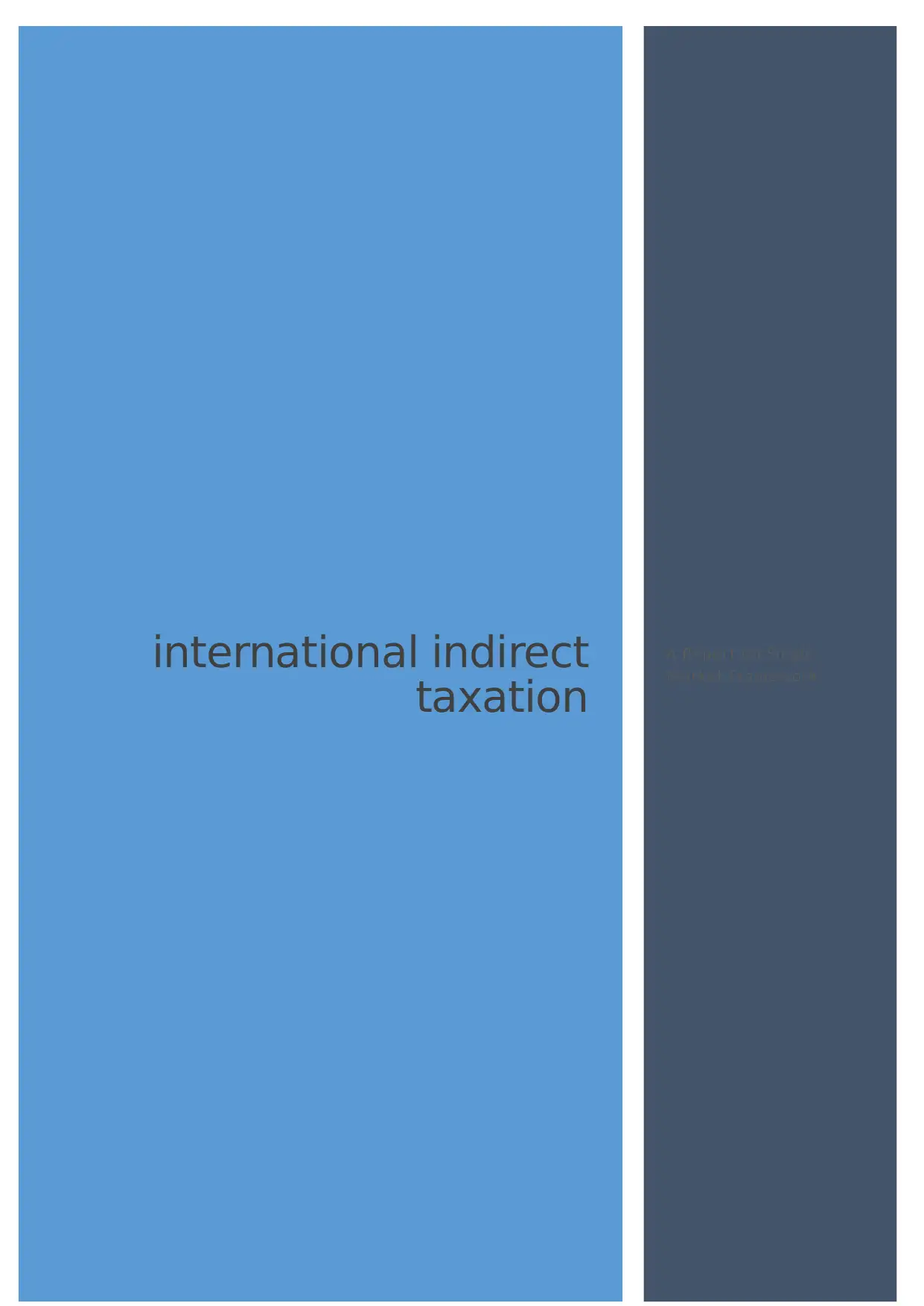
international indirect
taxation
A Report on Single
Market Framework
taxation
A Report on Single
Market Framework
Secure Best Marks with AI Grader
Need help grading? Try our AI Grader for instant feedback on your assignments.
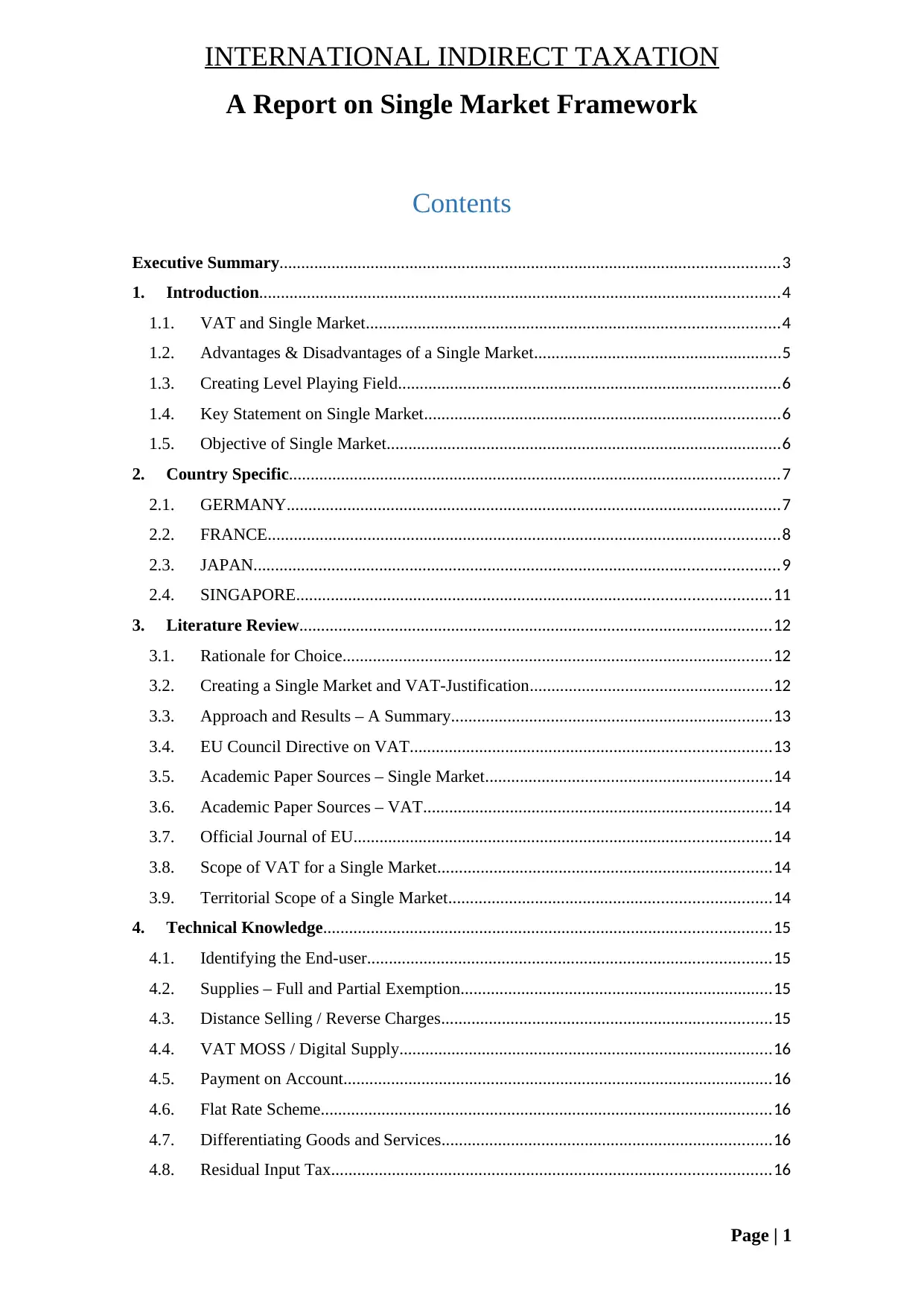
INTERNATIONAL INDIRECT TAXATION
A Report on Single Market Framework
Contents
Executive Summary...................................................................................................................3
1. Introduction........................................................................................................................4
1.1. VAT and Single Market...............................................................................................4
1.2. Advantages & Disadvantages of a Single Market.........................................................5
1.3. Creating Level Playing Field........................................................................................6
1.4. Key Statement on Single Market..................................................................................6
1.5. Objective of Single Market...........................................................................................6
2. Country Specific.................................................................................................................7
2.1. GERMANY..................................................................................................................7
2.2. FRANCE......................................................................................................................8
2.3. JAPAN.........................................................................................................................9
2.4. SINGAPORE.............................................................................................................11
3. Literature Review.............................................................................................................12
3.1. Rationale for Choice...................................................................................................12
3.2. Creating a Single Market and VAT-Justification........................................................12
3.3. Approach and Results – A Summary..........................................................................13
3.4. EU Council Directive on VAT...................................................................................13
3.5. Academic Paper Sources – Single Market..................................................................14
3.6. Academic Paper Sources – VAT................................................................................14
3.7. Official Journal of EU................................................................................................14
3.8. Scope of VAT for a Single Market.............................................................................14
3.9. Territorial Scope of a Single Market..........................................................................14
4. Technical Knowledge.......................................................................................................15
4.1. Identifying the End-user.............................................................................................15
4.2. Supplies – Full and Partial Exemption........................................................................15
4.3. Distance Selling / Reverse Charges............................................................................15
4.4. VAT MOSS / Digital Supply......................................................................................16
4.5. Payment on Account...................................................................................................16
4.6. Flat Rate Scheme........................................................................................................16
4.7. Differentiating Goods and Services............................................................................16
4.8. Residual Input Tax.....................................................................................................16
Page | 1
A Report on Single Market Framework
Contents
Executive Summary...................................................................................................................3
1. Introduction........................................................................................................................4
1.1. VAT and Single Market...............................................................................................4
1.2. Advantages & Disadvantages of a Single Market.........................................................5
1.3. Creating Level Playing Field........................................................................................6
1.4. Key Statement on Single Market..................................................................................6
1.5. Objective of Single Market...........................................................................................6
2. Country Specific.................................................................................................................7
2.1. GERMANY..................................................................................................................7
2.2. FRANCE......................................................................................................................8
2.3. JAPAN.........................................................................................................................9
2.4. SINGAPORE.............................................................................................................11
3. Literature Review.............................................................................................................12
3.1. Rationale for Choice...................................................................................................12
3.2. Creating a Single Market and VAT-Justification........................................................12
3.3. Approach and Results – A Summary..........................................................................13
3.4. EU Council Directive on VAT...................................................................................13
3.5. Academic Paper Sources – Single Market..................................................................14
3.6. Academic Paper Sources – VAT................................................................................14
3.7. Official Journal of EU................................................................................................14
3.8. Scope of VAT for a Single Market.............................................................................14
3.9. Territorial Scope of a Single Market..........................................................................14
4. Technical Knowledge.......................................................................................................15
4.1. Identifying the End-user.............................................................................................15
4.2. Supplies – Full and Partial Exemption........................................................................15
4.3. Distance Selling / Reverse Charges............................................................................15
4.4. VAT MOSS / Digital Supply......................................................................................16
4.5. Payment on Account...................................................................................................16
4.6. Flat Rate Scheme........................................................................................................16
4.7. Differentiating Goods and Services............................................................................16
4.8. Residual Input Tax.....................................................................................................16
Page | 1
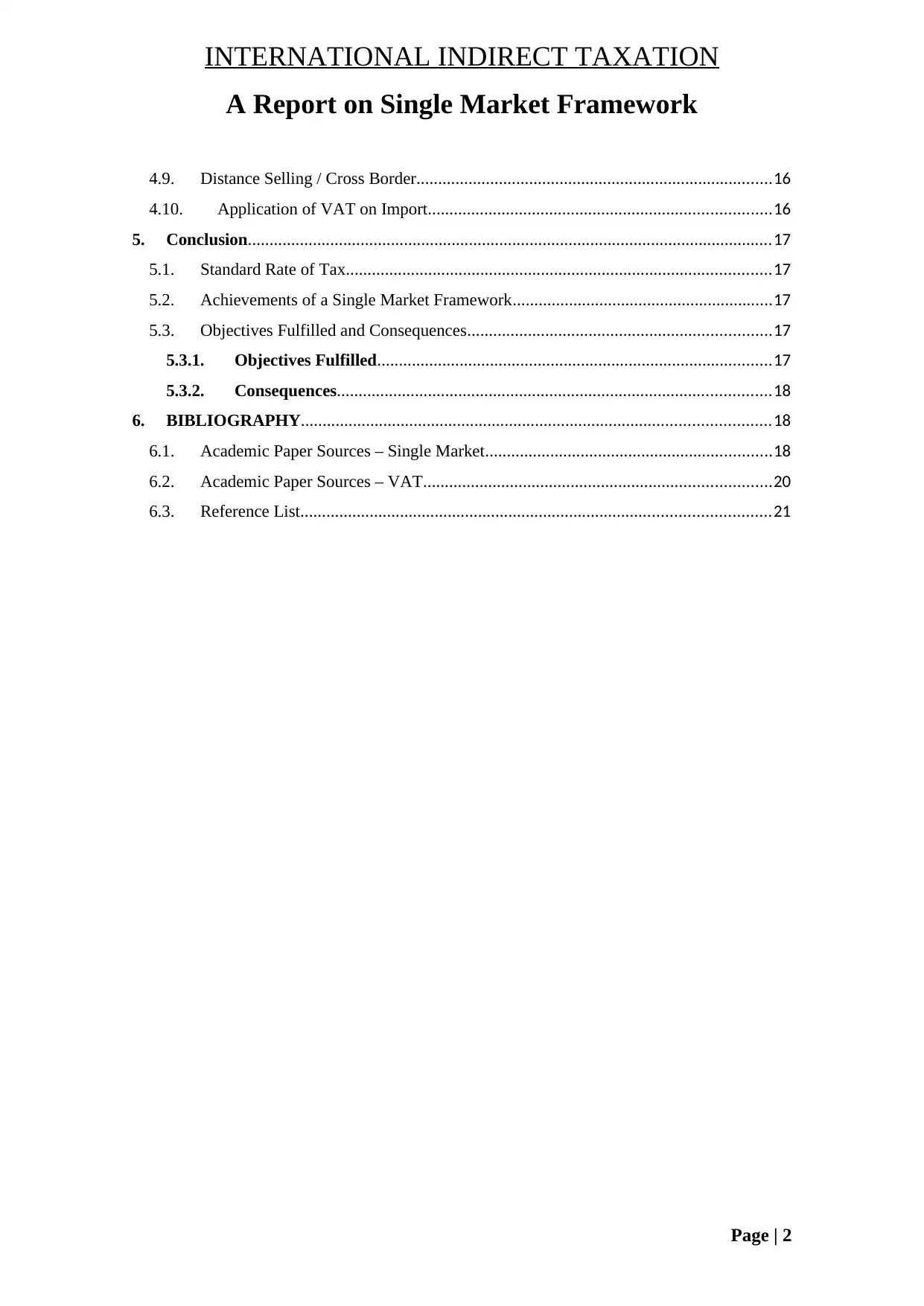
INTERNATIONAL INDIRECT TAXATION
A Report on Single Market Framework
4.9. Distance Selling / Cross Border..................................................................................16
4.10. Application of VAT on Import...............................................................................16
5. Conclusion.........................................................................................................................17
5.1. Standard Rate of Tax..................................................................................................17
5.2. Achievements of a Single Market Framework............................................................17
5.3. Objectives Fulfilled and Consequences......................................................................17
5.3.1. Objectives Fulfilled...........................................................................................17
5.3.2. Consequences....................................................................................................18
6. BIBLIOGRAPHY............................................................................................................18
6.1. Academic Paper Sources – Single Market..................................................................18
6.2. Academic Paper Sources – VAT................................................................................20
6.3. Reference List............................................................................................................21
Page | 2
A Report on Single Market Framework
4.9. Distance Selling / Cross Border..................................................................................16
4.10. Application of VAT on Import...............................................................................16
5. Conclusion.........................................................................................................................17
5.1. Standard Rate of Tax..................................................................................................17
5.2. Achievements of a Single Market Framework............................................................17
5.3. Objectives Fulfilled and Consequences......................................................................17
5.3.1. Objectives Fulfilled...........................................................................................17
5.3.2. Consequences....................................................................................................18
6. BIBLIOGRAPHY............................................................................................................18
6.1. Academic Paper Sources – Single Market..................................................................18
6.2. Academic Paper Sources – VAT................................................................................20
6.3. Reference List............................................................................................................21
Page | 2
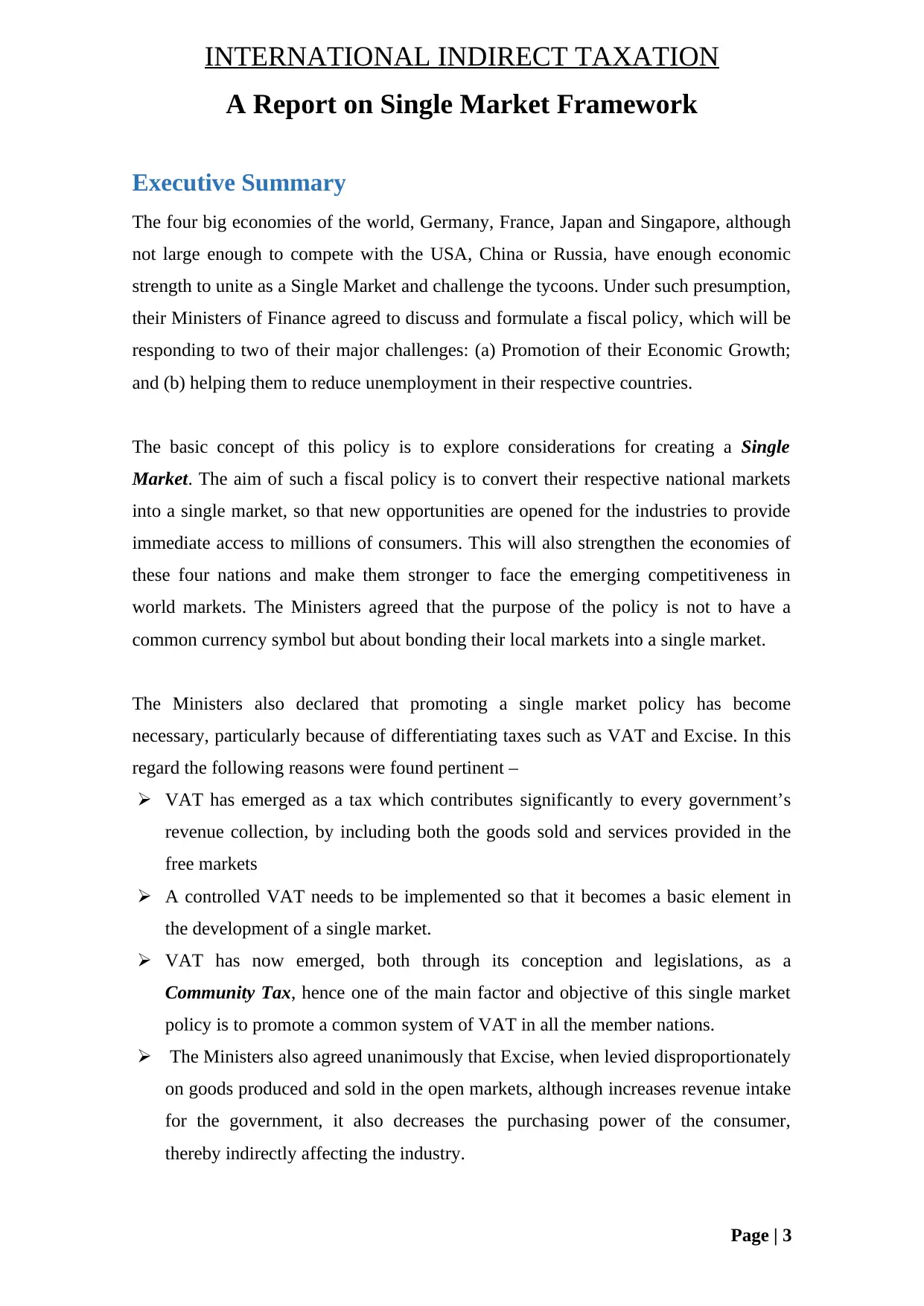
INTERNATIONAL INDIRECT TAXATION
A Report on Single Market Framework
Executive Summary
The four big economies of the world, Germany, France, Japan and Singapore, although
not large enough to compete with the USA, China or Russia, have enough economic
strength to unite as a Single Market and challenge the tycoons. Under such presumption,
their Ministers of Finance agreed to discuss and formulate a fiscal policy, which will be
responding to two of their major challenges: (a) Promotion of their Economic Growth;
and (b) helping them to reduce unemployment in their respective countries.
The basic concept of this policy is to explore considerations for creating a Single
Market. The aim of such a fiscal policy is to convert their respective national markets
into a single market, so that new opportunities are opened for the industries to provide
immediate access to millions of consumers. This will also strengthen the economies of
these four nations and make them stronger to face the emerging competitiveness in
world markets. The Ministers agreed that the purpose of the policy is not to have a
common currency symbol but about bonding their local markets into a single market.
The Ministers also declared that promoting a single market policy has become
necessary, particularly because of differentiating taxes such as VAT and Excise. In this
regard the following reasons were found pertinent –
VAT has emerged as a tax which contributes significantly to every government’s
revenue collection, by including both the goods sold and services provided in the
free markets
A controlled VAT needs to be implemented so that it becomes a basic element in
the development of a single market.
VAT has now emerged, both through its conception and legislations, as a
Community Tax, hence one of the main factor and objective of this single market
policy is to promote a common system of VAT in all the member nations.
The Ministers also agreed unanimously that Excise, when levied disproportionately
on goods produced and sold in the open markets, although increases revenue intake
for the government, it also decreases the purchasing power of the consumer,
thereby indirectly affecting the industry.
Page | 3
A Report on Single Market Framework
Executive Summary
The four big economies of the world, Germany, France, Japan and Singapore, although
not large enough to compete with the USA, China or Russia, have enough economic
strength to unite as a Single Market and challenge the tycoons. Under such presumption,
their Ministers of Finance agreed to discuss and formulate a fiscal policy, which will be
responding to two of their major challenges: (a) Promotion of their Economic Growth;
and (b) helping them to reduce unemployment in their respective countries.
The basic concept of this policy is to explore considerations for creating a Single
Market. The aim of such a fiscal policy is to convert their respective national markets
into a single market, so that new opportunities are opened for the industries to provide
immediate access to millions of consumers. This will also strengthen the economies of
these four nations and make them stronger to face the emerging competitiveness in
world markets. The Ministers agreed that the purpose of the policy is not to have a
common currency symbol but about bonding their local markets into a single market.
The Ministers also declared that promoting a single market policy has become
necessary, particularly because of differentiating taxes such as VAT and Excise. In this
regard the following reasons were found pertinent –
VAT has emerged as a tax which contributes significantly to every government’s
revenue collection, by including both the goods sold and services provided in the
free markets
A controlled VAT needs to be implemented so that it becomes a basic element in
the development of a single market.
VAT has now emerged, both through its conception and legislations, as a
Community Tax, hence one of the main factor and objective of this single market
policy is to promote a common system of VAT in all the member nations.
The Ministers also agreed unanimously that Excise, when levied disproportionately
on goods produced and sold in the open markets, although increases revenue intake
for the government, it also decreases the purchasing power of the consumer,
thereby indirectly affecting the industry.
Page | 3
Secure Best Marks with AI Grader
Need help grading? Try our AI Grader for instant feedback on your assignments.
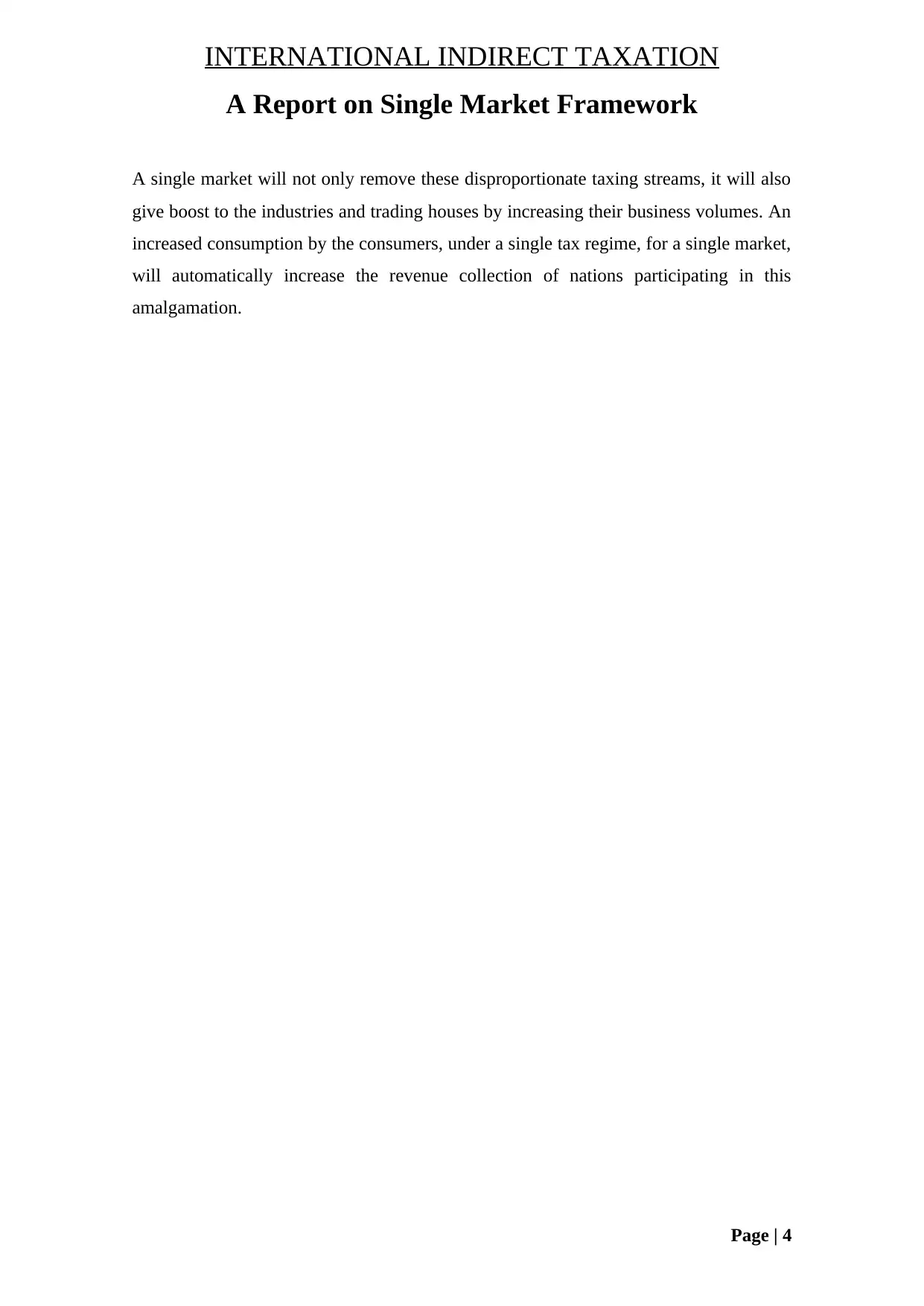
INTERNATIONAL INDIRECT TAXATION
A Report on Single Market Framework
A single market will not only remove these disproportionate taxing streams, it will also
give boost to the industries and trading houses by increasing their business volumes. An
increased consumption by the consumers, under a single tax regime, for a single market,
will automatically increase the revenue collection of nations participating in this
amalgamation.
Page | 4
A Report on Single Market Framework
A single market will not only remove these disproportionate taxing streams, it will also
give boost to the industries and trading houses by increasing their business volumes. An
increased consumption by the consumers, under a single tax regime, for a single market,
will automatically increase the revenue collection of nations participating in this
amalgamation.
Page | 4
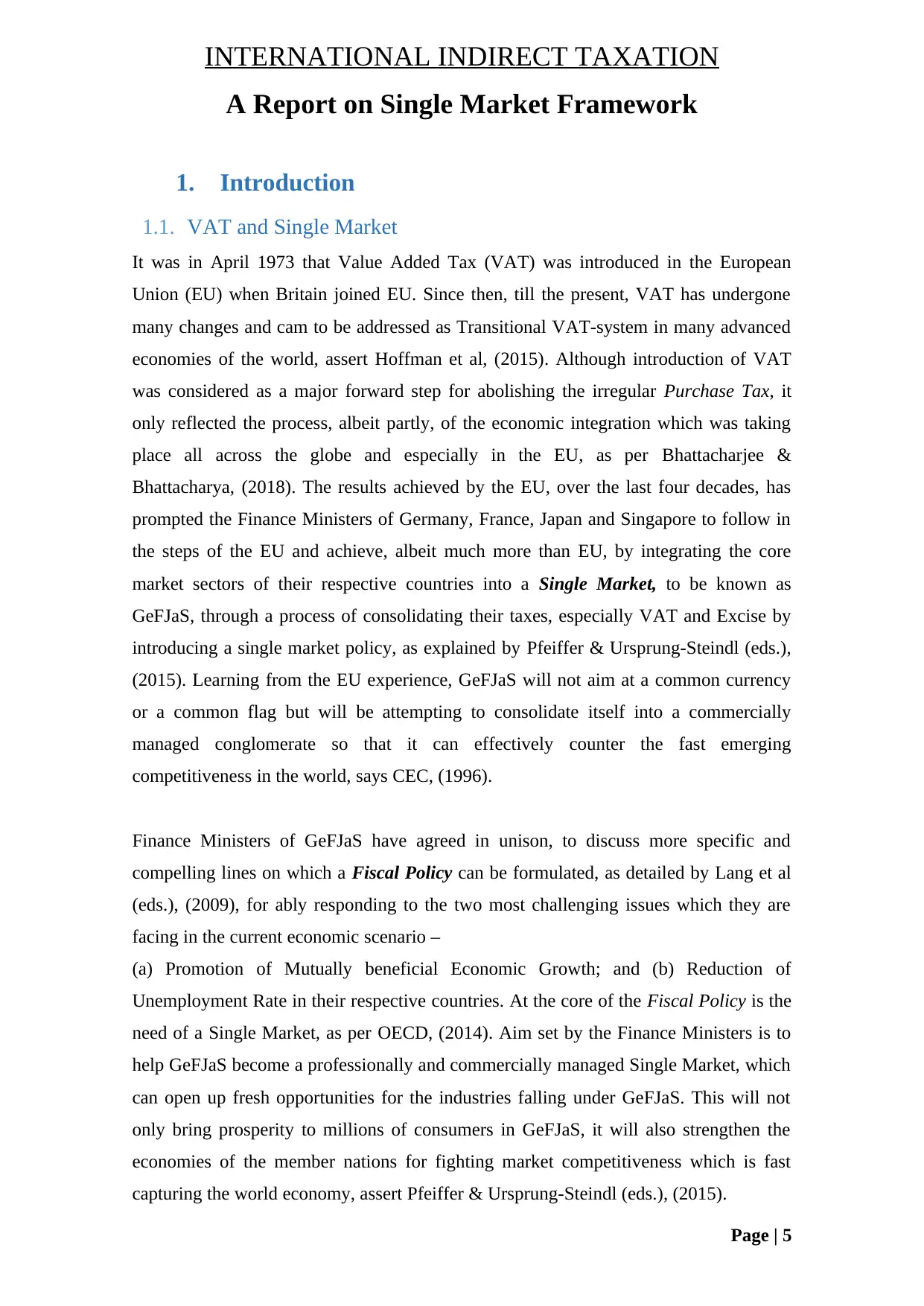
INTERNATIONAL INDIRECT TAXATION
A Report on Single Market Framework
1. Introduction
1.1. VAT and Single Market
It was in April 1973 that Value Added Tax (VAT) was introduced in the European
Union (EU) when Britain joined EU. Since then, till the present, VAT has undergone
many changes and cam to be addressed as Transitional VAT-system in many advanced
economies of the world, assert Hoffman et al, (2015). Although introduction of VAT
was considered as a major forward step for abolishing the irregular Purchase Tax, it
only reflected the process, albeit partly, of the economic integration which was taking
place all across the globe and especially in the EU, as per Bhattacharjee &
Bhattacharya, (2018). The results achieved by the EU, over the last four decades, has
prompted the Finance Ministers of Germany, France, Japan and Singapore to follow in
the steps of the EU and achieve, albeit much more than EU, by integrating the core
market sectors of their respective countries into a Single Market, to be known as
GeFJaS, through a process of consolidating their taxes, especially VAT and Excise by
introducing a single market policy, as explained by Pfeiffer & Ursprung-Steindl (eds.),
(2015). Learning from the EU experience, GeFJaS will not aim at a common currency
or a common flag but will be attempting to consolidate itself into a commercially
managed conglomerate so that it can effectively counter the fast emerging
competitiveness in the world, says CEC, (1996).
Finance Ministers of GeFJaS have agreed in unison, to discuss more specific and
compelling lines on which a Fiscal Policy can be formulated, as detailed by Lang et al
(eds.), (2009), for ably responding to the two most challenging issues which they are
facing in the current economic scenario –
(a) Promotion of Mutually beneficial Economic Growth; and (b) Reduction of
Unemployment Rate in their respective countries. At the core of the Fiscal Policy is the
need of a Single Market, as per OECD, (2014). Aim set by the Finance Ministers is to
help GeFJaS become a professionally and commercially managed Single Market, which
can open up fresh opportunities for the industries falling under GeFJaS. This will not
only bring prosperity to millions of consumers in GeFJaS, it will also strengthen the
economies of the member nations for fighting market competitiveness which is fast
capturing the world economy, assert Pfeiffer & Ursprung-Steindl (eds.), (2015).
Page | 5
A Report on Single Market Framework
1. Introduction
1.1. VAT and Single Market
It was in April 1973 that Value Added Tax (VAT) was introduced in the European
Union (EU) when Britain joined EU. Since then, till the present, VAT has undergone
many changes and cam to be addressed as Transitional VAT-system in many advanced
economies of the world, assert Hoffman et al, (2015). Although introduction of VAT
was considered as a major forward step for abolishing the irregular Purchase Tax, it
only reflected the process, albeit partly, of the economic integration which was taking
place all across the globe and especially in the EU, as per Bhattacharjee &
Bhattacharya, (2018). The results achieved by the EU, over the last four decades, has
prompted the Finance Ministers of Germany, France, Japan and Singapore to follow in
the steps of the EU and achieve, albeit much more than EU, by integrating the core
market sectors of their respective countries into a Single Market, to be known as
GeFJaS, through a process of consolidating their taxes, especially VAT and Excise by
introducing a single market policy, as explained by Pfeiffer & Ursprung-Steindl (eds.),
(2015). Learning from the EU experience, GeFJaS will not aim at a common currency
or a common flag but will be attempting to consolidate itself into a commercially
managed conglomerate so that it can effectively counter the fast emerging
competitiveness in the world, says CEC, (1996).
Finance Ministers of GeFJaS have agreed in unison, to discuss more specific and
compelling lines on which a Fiscal Policy can be formulated, as detailed by Lang et al
(eds.), (2009), for ably responding to the two most challenging issues which they are
facing in the current economic scenario –
(a) Promotion of Mutually beneficial Economic Growth; and (b) Reduction of
Unemployment Rate in their respective countries. At the core of the Fiscal Policy is the
need of a Single Market, as per OECD, (2014). Aim set by the Finance Ministers is to
help GeFJaS become a professionally and commercially managed Single Market, which
can open up fresh opportunities for the industries falling under GeFJaS. This will not
only bring prosperity to millions of consumers in GeFJaS, it will also strengthen the
economies of the member nations for fighting market competitiveness which is fast
capturing the world economy, assert Pfeiffer & Ursprung-Steindl (eds.), (2015).
Page | 5
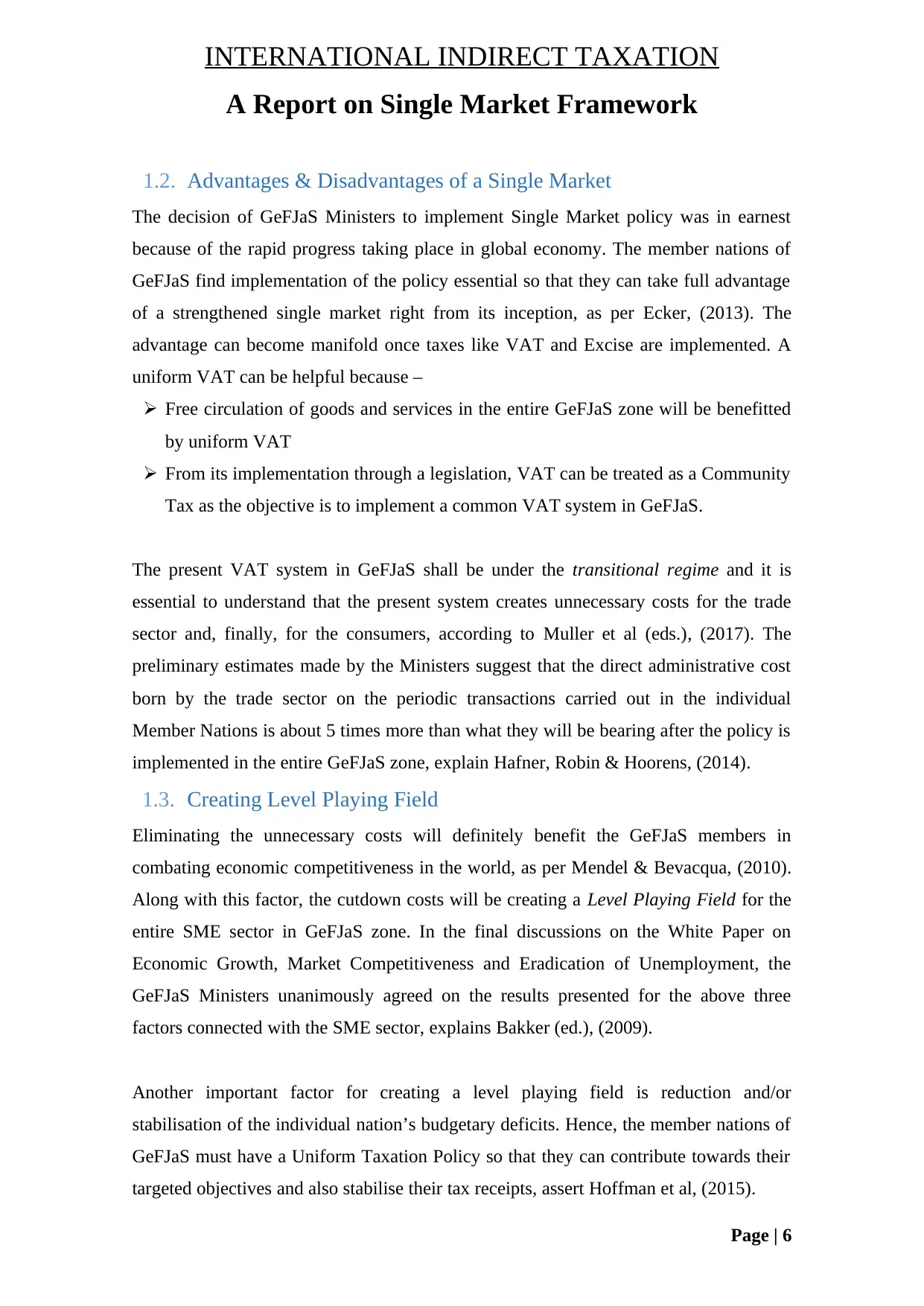
INTERNATIONAL INDIRECT TAXATION
A Report on Single Market Framework
1.2. Advantages & Disadvantages of a Single Market
The decision of GeFJaS Ministers to implement Single Market policy was in earnest
because of the rapid progress taking place in global economy. The member nations of
GeFJaS find implementation of the policy essential so that they can take full advantage
of a strengthened single market right from its inception, as per Ecker, (2013). The
advantage can become manifold once taxes like VAT and Excise are implemented. A
uniform VAT can be helpful because –
Free circulation of goods and services in the entire GeFJaS zone will be benefitted
by uniform VAT
From its implementation through a legislation, VAT can be treated as a Community
Tax as the objective is to implement a common VAT system in GeFJaS.
The present VAT system in GeFJaS shall be under the transitional regime and it is
essential to understand that the present system creates unnecessary costs for the trade
sector and, finally, for the consumers, according to Muller et al (eds.), (2017). The
preliminary estimates made by the Ministers suggest that the direct administrative cost
born by the trade sector on the periodic transactions carried out in the individual
Member Nations is about 5 times more than what they will be bearing after the policy is
implemented in the entire GeFJaS zone, explain Hafner, Robin & Hoorens, (2014).
1.3. Creating Level Playing Field
Eliminating the unnecessary costs will definitely benefit the GeFJaS members in
combating economic competitiveness in the world, as per Mendel & Bevacqua, (2010).
Along with this factor, the cutdown costs will be creating a Level Playing Field for the
entire SME sector in GeFJaS zone. In the final discussions on the White Paper on
Economic Growth, Market Competitiveness and Eradication of Unemployment, the
GeFJaS Ministers unanimously agreed on the results presented for the above three
factors connected with the SME sector, explains Bakker (ed.), (2009).
Another important factor for creating a level playing field is reduction and/or
stabilisation of the individual nation’s budgetary deficits. Hence, the member nations of
GeFJaS must have a Uniform Taxation Policy so that they can contribute towards their
targeted objectives and also stabilise their tax receipts, assert Hoffman et al, (2015).
Page | 6
A Report on Single Market Framework
1.2. Advantages & Disadvantages of a Single Market
The decision of GeFJaS Ministers to implement Single Market policy was in earnest
because of the rapid progress taking place in global economy. The member nations of
GeFJaS find implementation of the policy essential so that they can take full advantage
of a strengthened single market right from its inception, as per Ecker, (2013). The
advantage can become manifold once taxes like VAT and Excise are implemented. A
uniform VAT can be helpful because –
Free circulation of goods and services in the entire GeFJaS zone will be benefitted
by uniform VAT
From its implementation through a legislation, VAT can be treated as a Community
Tax as the objective is to implement a common VAT system in GeFJaS.
The present VAT system in GeFJaS shall be under the transitional regime and it is
essential to understand that the present system creates unnecessary costs for the trade
sector and, finally, for the consumers, according to Muller et al (eds.), (2017). The
preliminary estimates made by the Ministers suggest that the direct administrative cost
born by the trade sector on the periodic transactions carried out in the individual
Member Nations is about 5 times more than what they will be bearing after the policy is
implemented in the entire GeFJaS zone, explain Hafner, Robin & Hoorens, (2014).
1.3. Creating Level Playing Field
Eliminating the unnecessary costs will definitely benefit the GeFJaS members in
combating economic competitiveness in the world, as per Mendel & Bevacqua, (2010).
Along with this factor, the cutdown costs will be creating a Level Playing Field for the
entire SME sector in GeFJaS zone. In the final discussions on the White Paper on
Economic Growth, Market Competitiveness and Eradication of Unemployment, the
GeFJaS Ministers unanimously agreed on the results presented for the above three
factors connected with the SME sector, explains Bakker (ed.), (2009).
Another important factor for creating a level playing field is reduction and/or
stabilisation of the individual nation’s budgetary deficits. Hence, the member nations of
GeFJaS must have a Uniform Taxation Policy so that they can contribute towards their
targeted objectives and also stabilise their tax receipts, assert Hoffman et al, (2015).
Page | 6
Paraphrase This Document
Need a fresh take? Get an instant paraphrase of this document with our AI Paraphraser
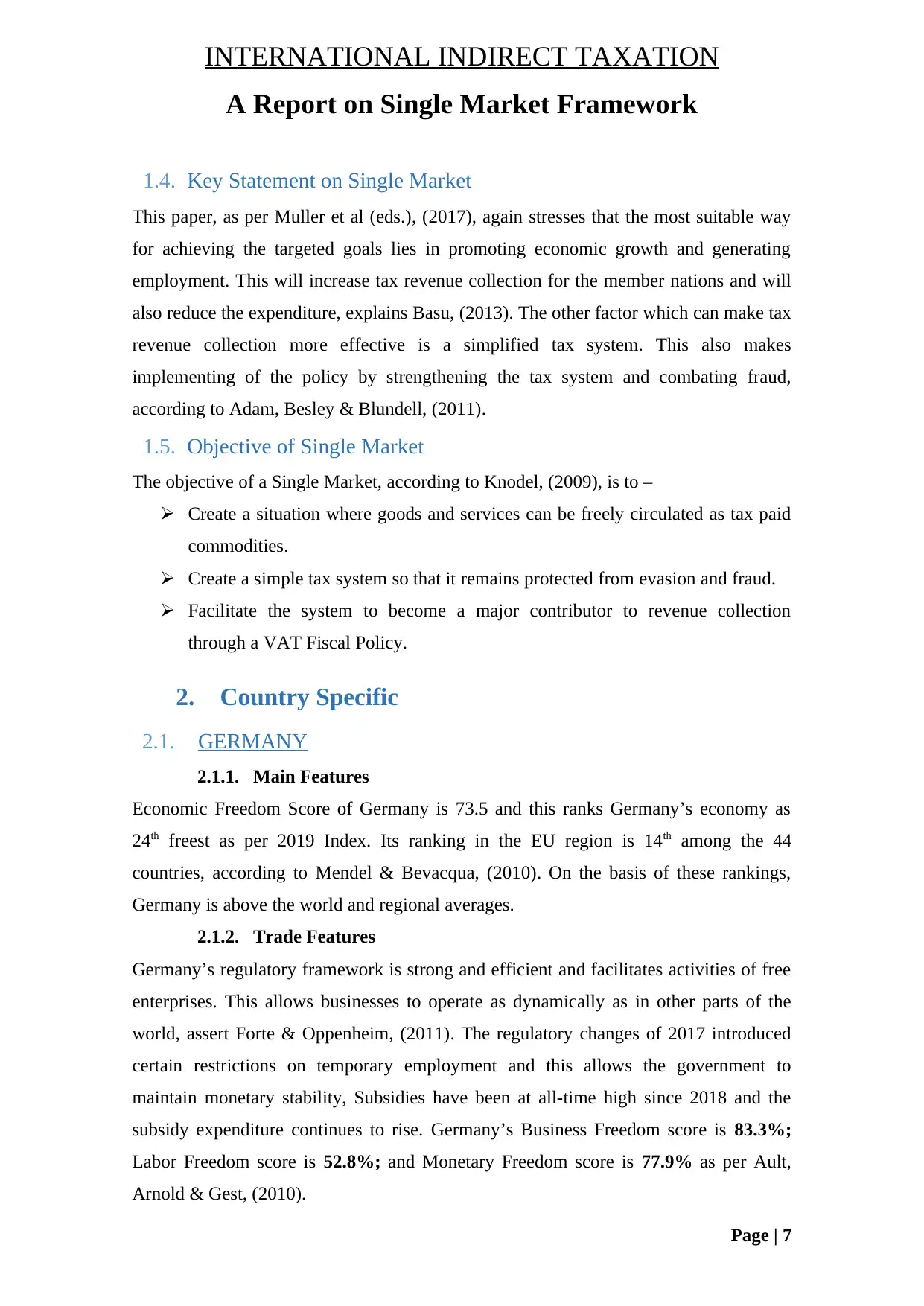
INTERNATIONAL INDIRECT TAXATION
A Report on Single Market Framework
1.4. Key Statement on Single Market
This paper, as per Muller et al (eds.), (2017), again stresses that the most suitable way
for achieving the targeted goals lies in promoting economic growth and generating
employment. This will increase tax revenue collection for the member nations and will
also reduce the expenditure, explains Basu, (2013). The other factor which can make tax
revenue collection more effective is a simplified tax system. This also makes
implementing of the policy by strengthening the tax system and combating fraud,
according to Adam, Besley & Blundell, (2011).
1.5. Objective of Single Market
The objective of a Single Market, according to Knodel, (2009), is to –
Create a situation where goods and services can be freely circulated as tax paid
commodities.
Create a simple tax system so that it remains protected from evasion and fraud.
Facilitate the system to become a major contributor to revenue collection
through a VAT Fiscal Policy.
2. Country Specific
2.1. GERMANY
2.1.1. Main Features
Economic Freedom Score of Germany is 73.5 and this ranks Germany’s economy as
24th freest as per 2019 Index. Its ranking in the EU region is 14th among the 44
countries, according to Mendel & Bevacqua, (2010). On the basis of these rankings,
Germany is above the world and regional averages.
2.1.2. Trade Features
Germany’s regulatory framework is strong and efficient and facilitates activities of free
enterprises. This allows businesses to operate as dynamically as in other parts of the
world, assert Forte & Oppenheim, (2011). The regulatory changes of 2017 introduced
certain restrictions on temporary employment and this allows the government to
maintain monetary stability, Subsidies have been at all-time high since 2018 and the
subsidy expenditure continues to rise. Germany’s Business Freedom score is 83.3%;
Labor Freedom score is 52.8%; and Monetary Freedom score is 77.9% as per Ault,
Arnold & Gest, (2010).
Page | 7
A Report on Single Market Framework
1.4. Key Statement on Single Market
This paper, as per Muller et al (eds.), (2017), again stresses that the most suitable way
for achieving the targeted goals lies in promoting economic growth and generating
employment. This will increase tax revenue collection for the member nations and will
also reduce the expenditure, explains Basu, (2013). The other factor which can make tax
revenue collection more effective is a simplified tax system. This also makes
implementing of the policy by strengthening the tax system and combating fraud,
according to Adam, Besley & Blundell, (2011).
1.5. Objective of Single Market
The objective of a Single Market, according to Knodel, (2009), is to –
Create a situation where goods and services can be freely circulated as tax paid
commodities.
Create a simple tax system so that it remains protected from evasion and fraud.
Facilitate the system to become a major contributor to revenue collection
through a VAT Fiscal Policy.
2. Country Specific
2.1. GERMANY
2.1.1. Main Features
Economic Freedom Score of Germany is 73.5 and this ranks Germany’s economy as
24th freest as per 2019 Index. Its ranking in the EU region is 14th among the 44
countries, according to Mendel & Bevacqua, (2010). On the basis of these rankings,
Germany is above the world and regional averages.
2.1.2. Trade Features
Germany’s regulatory framework is strong and efficient and facilitates activities of free
enterprises. This allows businesses to operate as dynamically as in other parts of the
world, assert Forte & Oppenheim, (2011). The regulatory changes of 2017 introduced
certain restrictions on temporary employment and this allows the government to
maintain monetary stability, Subsidies have been at all-time high since 2018 and the
subsidy expenditure continues to rise. Germany’s Business Freedom score is 83.3%;
Labor Freedom score is 52.8%; and Monetary Freedom score is 77.9% as per Ault,
Arnold & Gest, (2010).
Page | 7
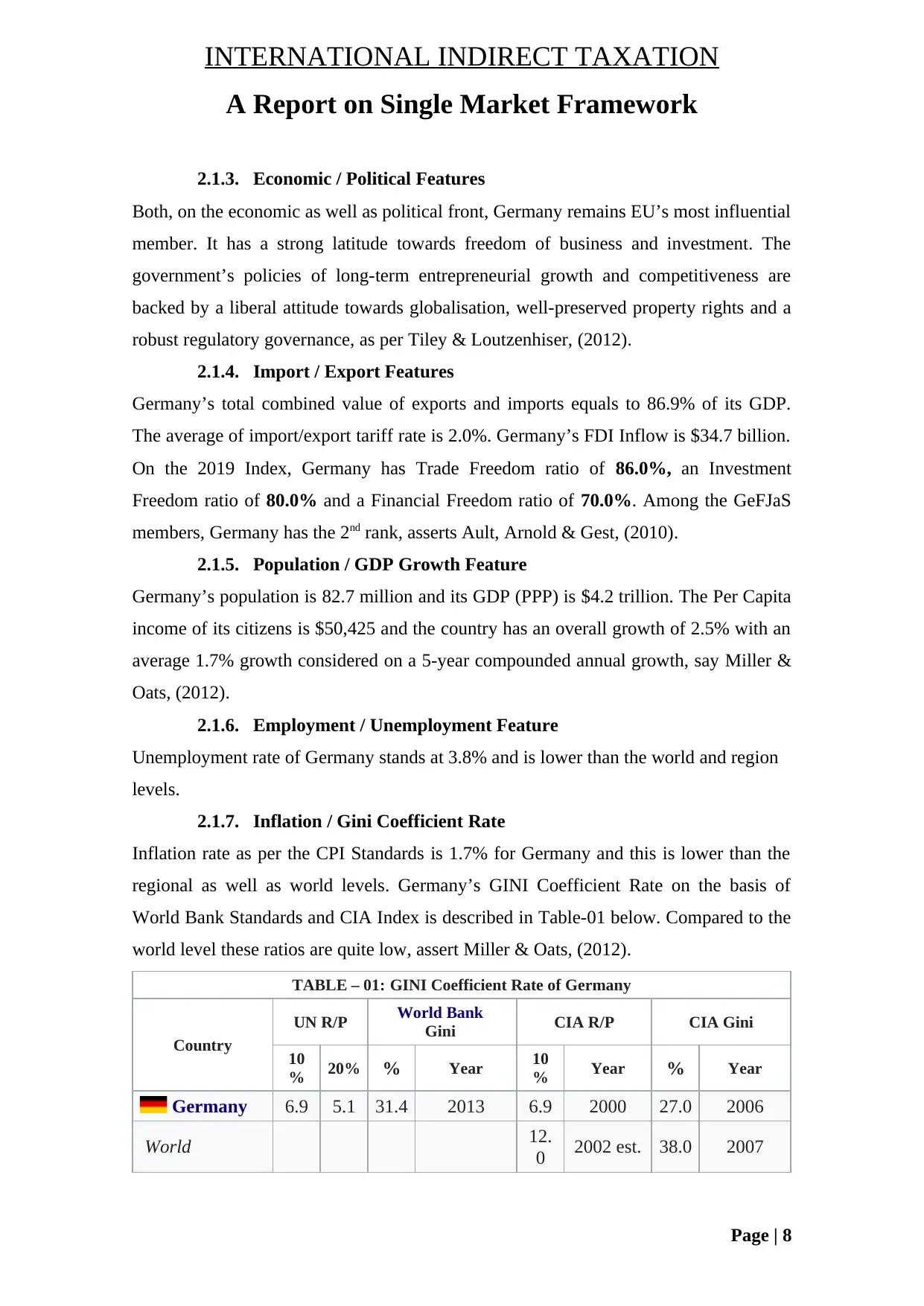
INTERNATIONAL INDIRECT TAXATION
A Report on Single Market Framework
2.1.3. Economic / Political Features
Both, on the economic as well as political front, Germany remains EU’s most influential
member. It has a strong latitude towards freedom of business and investment. The
government’s policies of long-term entrepreneurial growth and competitiveness are
backed by a liberal attitude towards globalisation, well-preserved property rights and a
robust regulatory governance, as per Tiley & Loutzenhiser, (2012).
2.1.4. Import / Export Features
Germany’s total combined value of exports and imports equals to 86.9% of its GDP.
The average of import/export tariff rate is 2.0%. Germany’s FDI Inflow is $34.7 billion.
On the 2019 Index, Germany has Trade Freedom ratio of 86.0%, an Investment
Freedom ratio of 80.0% and a Financial Freedom ratio of 70.0%. Among the GeFJaS
members, Germany has the 2nd rank, asserts Ault, Arnold & Gest, (2010).
2.1.5. Population / GDP Growth Feature
Germany’s population is 82.7 million and its GDP (PPP) is $4.2 trillion. The Per Capita
income of its citizens is $50,425 and the country has an overall growth of 2.5% with an
average 1.7% growth considered on a 5-year compounded annual growth, say Miller &
Oats, (2012).
2.1.6. Employment / Unemployment Feature
Unemployment rate of Germany stands at 3.8% and is lower than the world and region
levels.
2.1.7. Inflation / Gini Coefficient Rate
Inflation rate as per the CPI Standards is 1.7% for Germany and this is lower than the
regional as well as world levels. Germany’s GINI Coefficient Rate on the basis of
World Bank Standards and CIA Index is described in Table-01 below. Compared to the
world level these ratios are quite low, assert Miller & Oats, (2012).
TABLE – 01: GINI Coefficient Rate of Germany
Country
UN R/P World Bank
Gini CIA R/P CIA Gini
10
% 20% % Year 10
% Year % Year
Germany 6.9 5.1 31.4 2013 6.9 2000 27.0 2006
World 12.
0 2002 est. 38.0 2007
Page | 8
A Report on Single Market Framework
2.1.3. Economic / Political Features
Both, on the economic as well as political front, Germany remains EU’s most influential
member. It has a strong latitude towards freedom of business and investment. The
government’s policies of long-term entrepreneurial growth and competitiveness are
backed by a liberal attitude towards globalisation, well-preserved property rights and a
robust regulatory governance, as per Tiley & Loutzenhiser, (2012).
2.1.4. Import / Export Features
Germany’s total combined value of exports and imports equals to 86.9% of its GDP.
The average of import/export tariff rate is 2.0%. Germany’s FDI Inflow is $34.7 billion.
On the 2019 Index, Germany has Trade Freedom ratio of 86.0%, an Investment
Freedom ratio of 80.0% and a Financial Freedom ratio of 70.0%. Among the GeFJaS
members, Germany has the 2nd rank, asserts Ault, Arnold & Gest, (2010).
2.1.5. Population / GDP Growth Feature
Germany’s population is 82.7 million and its GDP (PPP) is $4.2 trillion. The Per Capita
income of its citizens is $50,425 and the country has an overall growth of 2.5% with an
average 1.7% growth considered on a 5-year compounded annual growth, say Miller &
Oats, (2012).
2.1.6. Employment / Unemployment Feature
Unemployment rate of Germany stands at 3.8% and is lower than the world and region
levels.
2.1.7. Inflation / Gini Coefficient Rate
Inflation rate as per the CPI Standards is 1.7% for Germany and this is lower than the
regional as well as world levels. Germany’s GINI Coefficient Rate on the basis of
World Bank Standards and CIA Index is described in Table-01 below. Compared to the
world level these ratios are quite low, assert Miller & Oats, (2012).
TABLE – 01: GINI Coefficient Rate of Germany
Country
UN R/P World Bank
Gini CIA R/P CIA Gini
10
% 20% % Year 10
% Year % Year
Germany 6.9 5.1 31.4 2013 6.9 2000 27.0 2006
World 12.
0 2002 est. 38.0 2007
Page | 8
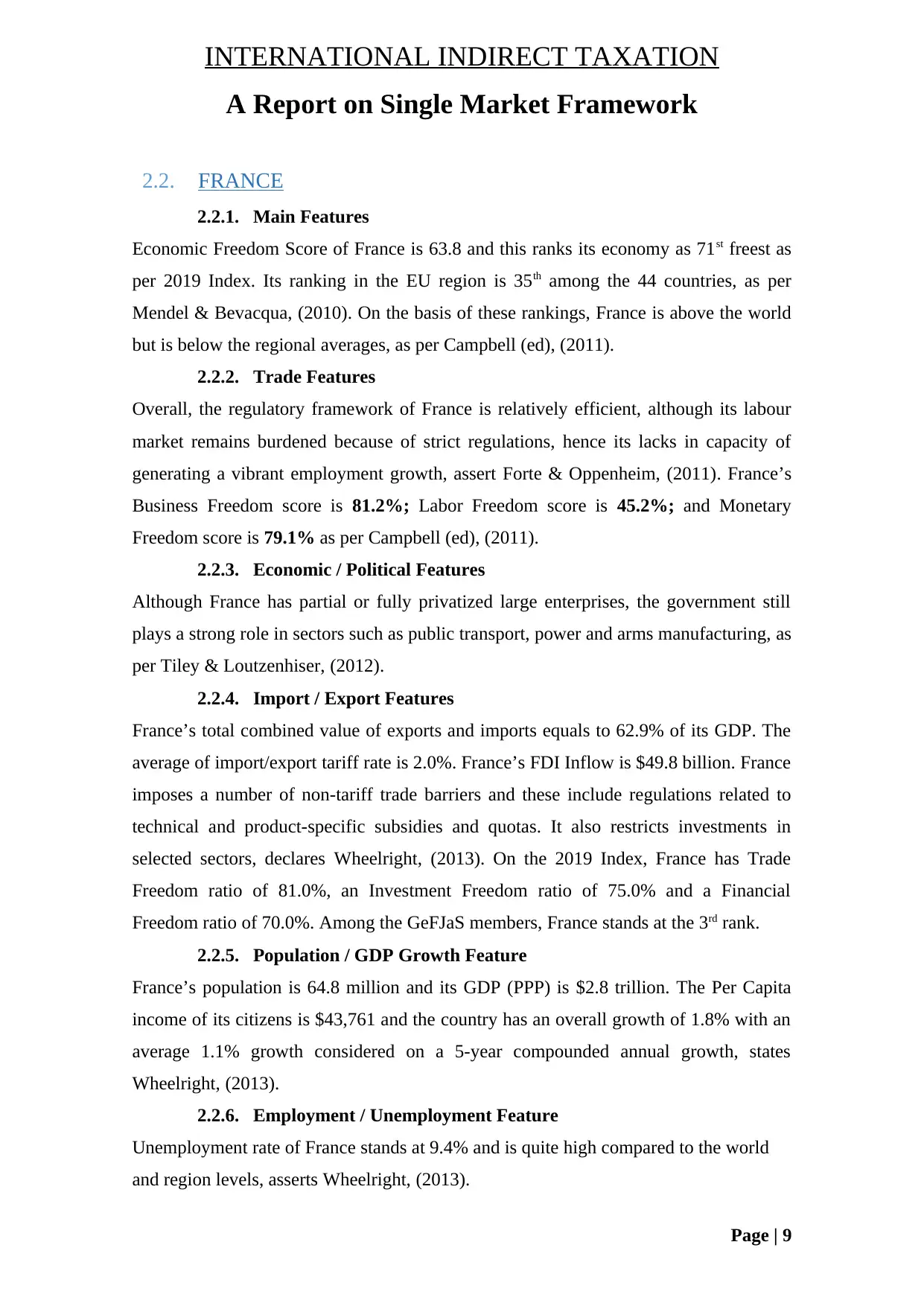
INTERNATIONAL INDIRECT TAXATION
A Report on Single Market Framework
2.2. FRANCE
2.2.1. Main Features
Economic Freedom Score of France is 63.8 and this ranks its economy as 71st freest as
per 2019 Index. Its ranking in the EU region is 35th among the 44 countries, as per
Mendel & Bevacqua, (2010). On the basis of these rankings, France is above the world
but is below the regional averages, as per Campbell (ed), (2011).
2.2.2. Trade Features
Overall, the regulatory framework of France is relatively efficient, although its labour
market remains burdened because of strict regulations, hence its lacks in capacity of
generating a vibrant employment growth, assert Forte & Oppenheim, (2011). France’s
Business Freedom score is 81.2%; Labor Freedom score is 45.2%; and Monetary
Freedom score is 79.1% as per Campbell (ed), (2011).
2.2.3. Economic / Political Features
Although France has partial or fully privatized large enterprises, the government still
plays a strong role in sectors such as public transport, power and arms manufacturing, as
per Tiley & Loutzenhiser, (2012).
2.2.4. Import / Export Features
France’s total combined value of exports and imports equals to 62.9% of its GDP. The
average of import/export tariff rate is 2.0%. France’s FDI Inflow is $49.8 billion. France
imposes a number of non-tariff trade barriers and these include regulations related to
technical and product-specific subsidies and quotas. It also restricts investments in
selected sectors, declares Wheelright, (2013). On the 2019 Index, France has Trade
Freedom ratio of 81.0%, an Investment Freedom ratio of 75.0% and a Financial
Freedom ratio of 70.0%. Among the GeFJaS members, France stands at the 3rd rank.
2.2.5. Population / GDP Growth Feature
France’s population is 64.8 million and its GDP (PPP) is $2.8 trillion. The Per Capita
income of its citizens is $43,761 and the country has an overall growth of 1.8% with an
average 1.1% growth considered on a 5-year compounded annual growth, states
Wheelright, (2013).
2.2.6. Employment / Unemployment Feature
Unemployment rate of France stands at 9.4% and is quite high compared to the world
and region levels, asserts Wheelright, (2013).
Page | 9
A Report on Single Market Framework
2.2. FRANCE
2.2.1. Main Features
Economic Freedom Score of France is 63.8 and this ranks its economy as 71st freest as
per 2019 Index. Its ranking in the EU region is 35th among the 44 countries, as per
Mendel & Bevacqua, (2010). On the basis of these rankings, France is above the world
but is below the regional averages, as per Campbell (ed), (2011).
2.2.2. Trade Features
Overall, the regulatory framework of France is relatively efficient, although its labour
market remains burdened because of strict regulations, hence its lacks in capacity of
generating a vibrant employment growth, assert Forte & Oppenheim, (2011). France’s
Business Freedom score is 81.2%; Labor Freedom score is 45.2%; and Monetary
Freedom score is 79.1% as per Campbell (ed), (2011).
2.2.3. Economic / Political Features
Although France has partial or fully privatized large enterprises, the government still
plays a strong role in sectors such as public transport, power and arms manufacturing, as
per Tiley & Loutzenhiser, (2012).
2.2.4. Import / Export Features
France’s total combined value of exports and imports equals to 62.9% of its GDP. The
average of import/export tariff rate is 2.0%. France’s FDI Inflow is $49.8 billion. France
imposes a number of non-tariff trade barriers and these include regulations related to
technical and product-specific subsidies and quotas. It also restricts investments in
selected sectors, declares Wheelright, (2013). On the 2019 Index, France has Trade
Freedom ratio of 81.0%, an Investment Freedom ratio of 75.0% and a Financial
Freedom ratio of 70.0%. Among the GeFJaS members, France stands at the 3rd rank.
2.2.5. Population / GDP Growth Feature
France’s population is 64.8 million and its GDP (PPP) is $2.8 trillion. The Per Capita
income of its citizens is $43,761 and the country has an overall growth of 1.8% with an
average 1.1% growth considered on a 5-year compounded annual growth, states
Wheelright, (2013).
2.2.6. Employment / Unemployment Feature
Unemployment rate of France stands at 9.4% and is quite high compared to the world
and region levels, asserts Wheelright, (2013).
Page | 9
Secure Best Marks with AI Grader
Need help grading? Try our AI Grader for instant feedback on your assignments.
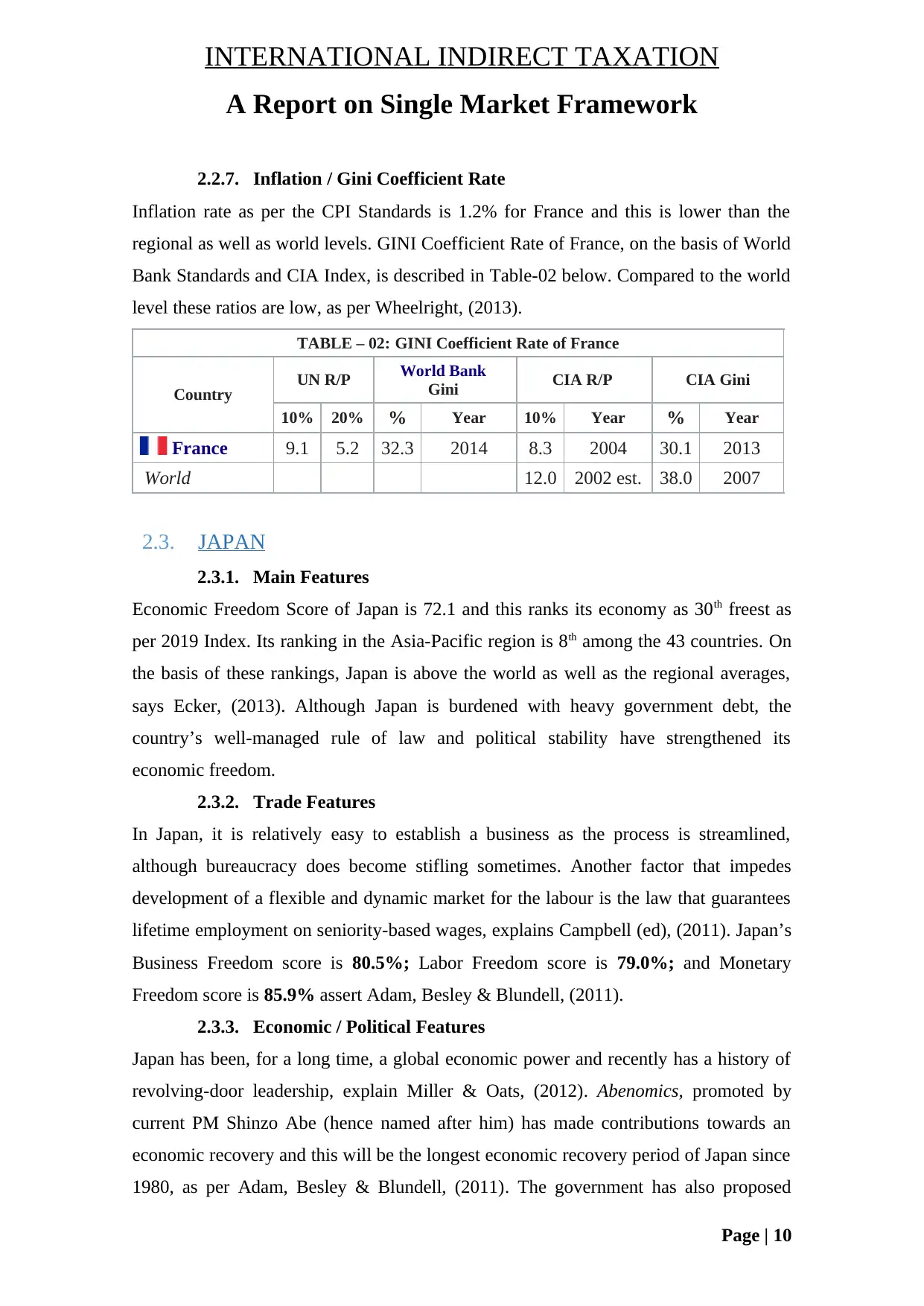
INTERNATIONAL INDIRECT TAXATION
A Report on Single Market Framework
2.2.7. Inflation / Gini Coefficient Rate
Inflation rate as per the CPI Standards is 1.2% for France and this is lower than the
regional as well as world levels. GINI Coefficient Rate of France, on the basis of World
Bank Standards and CIA Index, is described in Table-02 below. Compared to the world
level these ratios are low, as per Wheelright, (2013).
TABLE – 02: GINI Coefficient Rate of France
Country UN R/P World Bank
Gini CIA R/P CIA Gini
10% 20% % Year 10% Year % Year
France 9.1 5.2 32.3 2014 8.3 2004 30.1 2013
World 12.0 2002 est. 38.0 2007
2.3. JAPAN
2.3.1. Main Features
Economic Freedom Score of Japan is 72.1 and this ranks its economy as 30th freest as
per 2019 Index. Its ranking in the Asia-Pacific region is 8th among the 43 countries. On
the basis of these rankings, Japan is above the world as well as the regional averages,
says Ecker, (2013). Although Japan is burdened with heavy government debt, the
country’s well-managed rule of law and political stability have strengthened its
economic freedom.
2.3.2. Trade Features
In Japan, it is relatively easy to establish a business as the process is streamlined,
although bureaucracy does become stifling sometimes. Another factor that impedes
development of a flexible and dynamic market for the labour is the law that guarantees
lifetime employment on seniority-based wages, explains Campbell (ed), (2011). Japan’s
Business Freedom score is 80.5%; Labor Freedom score is 79.0%; and Monetary
Freedom score is 85.9% assert Adam, Besley & Blundell, (2011).
2.3.3. Economic / Political Features
Japan has been, for a long time, a global economic power and recently has a history of
revolving-door leadership, explain Miller & Oats, (2012). Abenomics, promoted by
current PM Shinzo Abe (hence named after him) has made contributions towards an
economic recovery and this will be the longest economic recovery period of Japan since
1980, as per Adam, Besley & Blundell, (2011). The government has also proposed
Page | 10
A Report on Single Market Framework
2.2.7. Inflation / Gini Coefficient Rate
Inflation rate as per the CPI Standards is 1.2% for France and this is lower than the
regional as well as world levels. GINI Coefficient Rate of France, on the basis of World
Bank Standards and CIA Index, is described in Table-02 below. Compared to the world
level these ratios are low, as per Wheelright, (2013).
TABLE – 02: GINI Coefficient Rate of France
Country UN R/P World Bank
Gini CIA R/P CIA Gini
10% 20% % Year 10% Year % Year
France 9.1 5.2 32.3 2014 8.3 2004 30.1 2013
World 12.0 2002 est. 38.0 2007
2.3. JAPAN
2.3.1. Main Features
Economic Freedom Score of Japan is 72.1 and this ranks its economy as 30th freest as
per 2019 Index. Its ranking in the Asia-Pacific region is 8th among the 43 countries. On
the basis of these rankings, Japan is above the world as well as the regional averages,
says Ecker, (2013). Although Japan is burdened with heavy government debt, the
country’s well-managed rule of law and political stability have strengthened its
economic freedom.
2.3.2. Trade Features
In Japan, it is relatively easy to establish a business as the process is streamlined,
although bureaucracy does become stifling sometimes. Another factor that impedes
development of a flexible and dynamic market for the labour is the law that guarantees
lifetime employment on seniority-based wages, explains Campbell (ed), (2011). Japan’s
Business Freedom score is 80.5%; Labor Freedom score is 79.0%; and Monetary
Freedom score is 85.9% assert Adam, Besley & Blundell, (2011).
2.3.3. Economic / Political Features
Japan has been, for a long time, a global economic power and recently has a history of
revolving-door leadership, explain Miller & Oats, (2012). Abenomics, promoted by
current PM Shinzo Abe (hence named after him) has made contributions towards an
economic recovery and this will be the longest economic recovery period of Japan since
1980, as per Adam, Besley & Blundell, (2011). The government has also proposed
Page | 10
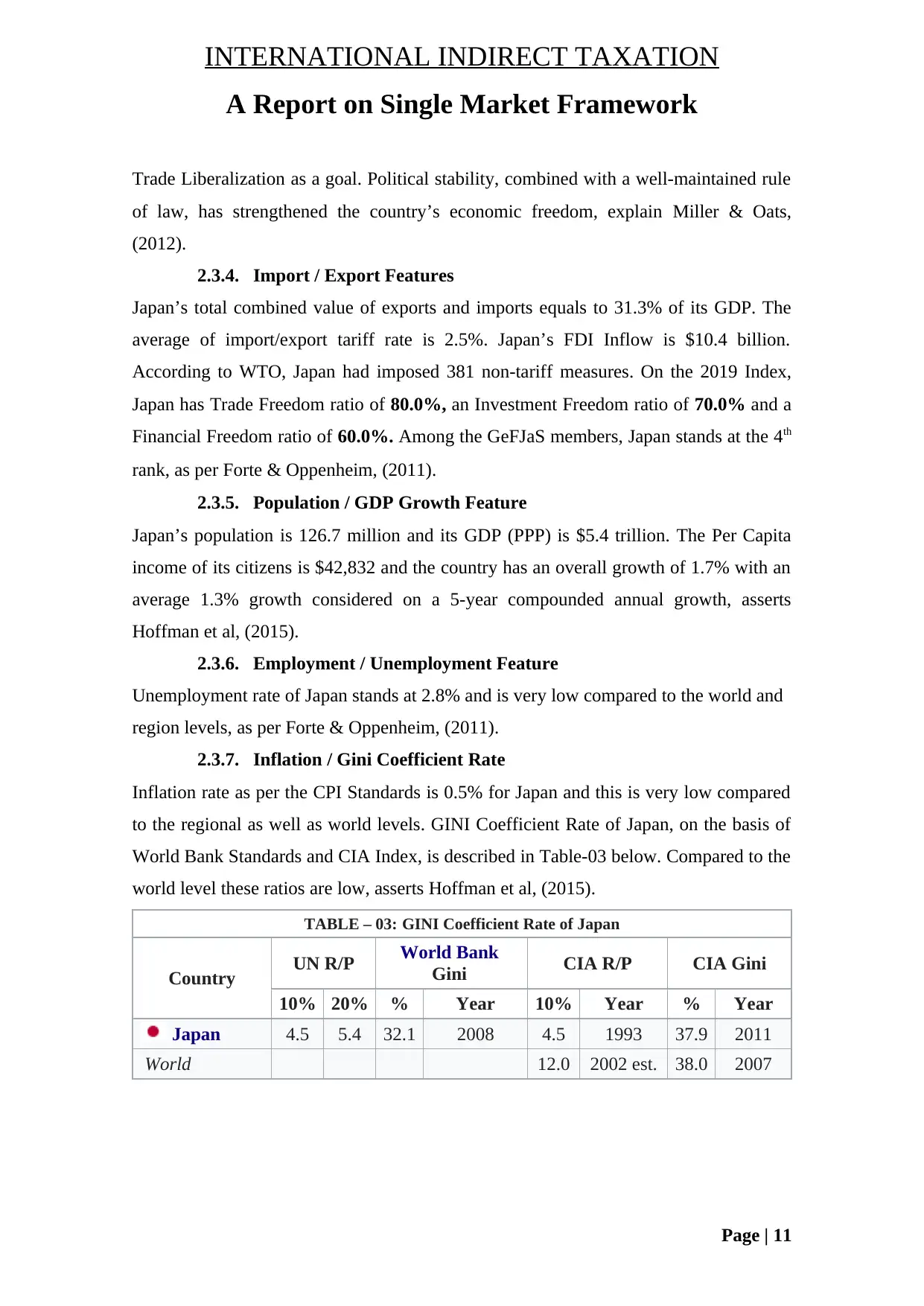
INTERNATIONAL INDIRECT TAXATION
A Report on Single Market Framework
Trade Liberalization as a goal. Political stability, combined with a well-maintained rule
of law, has strengthened the country’s economic freedom, explain Miller & Oats,
(2012).
2.3.4. Import / Export Features
Japan’s total combined value of exports and imports equals to 31.3% of its GDP. The
average of import/export tariff rate is 2.5%. Japan’s FDI Inflow is $10.4 billion.
According to WTO, Japan had imposed 381 non-tariff measures. On the 2019 Index,
Japan has Trade Freedom ratio of 80.0%, an Investment Freedom ratio of 70.0% and a
Financial Freedom ratio of 60.0%. Among the GeFJaS members, Japan stands at the 4th
rank, as per Forte & Oppenheim, (2011).
2.3.5. Population / GDP Growth Feature
Japan’s population is 126.7 million and its GDP (PPP) is $5.4 trillion. The Per Capita
income of its citizens is $42,832 and the country has an overall growth of 1.7% with an
average 1.3% growth considered on a 5-year compounded annual growth, asserts
Hoffman et al, (2015).
2.3.6. Employment / Unemployment Feature
Unemployment rate of Japan stands at 2.8% and is very low compared to the world and
region levels, as per Forte & Oppenheim, (2011).
2.3.7. Inflation / Gini Coefficient Rate
Inflation rate as per the CPI Standards is 0.5% for Japan and this is very low compared
to the regional as well as world levels. GINI Coefficient Rate of Japan, on the basis of
World Bank Standards and CIA Index, is described in Table-03 below. Compared to the
world level these ratios are low, asserts Hoffman et al, (2015).
TABLE – 03: GINI Coefficient Rate of Japan
Country UN R/P World Bank
Gini CIA R/P CIA Gini
10% 20% % Year 10% Year % Year
Japan 4.5 5.4 32.1 2008 4.5 1993 37.9 2011
World 12.0 2002 est. 38.0 2007
Page | 11
A Report on Single Market Framework
Trade Liberalization as a goal. Political stability, combined with a well-maintained rule
of law, has strengthened the country’s economic freedom, explain Miller & Oats,
(2012).
2.3.4. Import / Export Features
Japan’s total combined value of exports and imports equals to 31.3% of its GDP. The
average of import/export tariff rate is 2.5%. Japan’s FDI Inflow is $10.4 billion.
According to WTO, Japan had imposed 381 non-tariff measures. On the 2019 Index,
Japan has Trade Freedom ratio of 80.0%, an Investment Freedom ratio of 70.0% and a
Financial Freedom ratio of 60.0%. Among the GeFJaS members, Japan stands at the 4th
rank, as per Forte & Oppenheim, (2011).
2.3.5. Population / GDP Growth Feature
Japan’s population is 126.7 million and its GDP (PPP) is $5.4 trillion. The Per Capita
income of its citizens is $42,832 and the country has an overall growth of 1.7% with an
average 1.3% growth considered on a 5-year compounded annual growth, asserts
Hoffman et al, (2015).
2.3.6. Employment / Unemployment Feature
Unemployment rate of Japan stands at 2.8% and is very low compared to the world and
region levels, as per Forte & Oppenheim, (2011).
2.3.7. Inflation / Gini Coefficient Rate
Inflation rate as per the CPI Standards is 0.5% for Japan and this is very low compared
to the regional as well as world levels. GINI Coefficient Rate of Japan, on the basis of
World Bank Standards and CIA Index, is described in Table-03 below. Compared to the
world level these ratios are low, asserts Hoffman et al, (2015).
TABLE – 03: GINI Coefficient Rate of Japan
Country UN R/P World Bank
Gini CIA R/P CIA Gini
10% 20% % Year 10% Year % Year
Japan 4.5 5.4 32.1 2008 4.5 1993 37.9 2011
World 12.0 2002 est. 38.0 2007
Page | 11
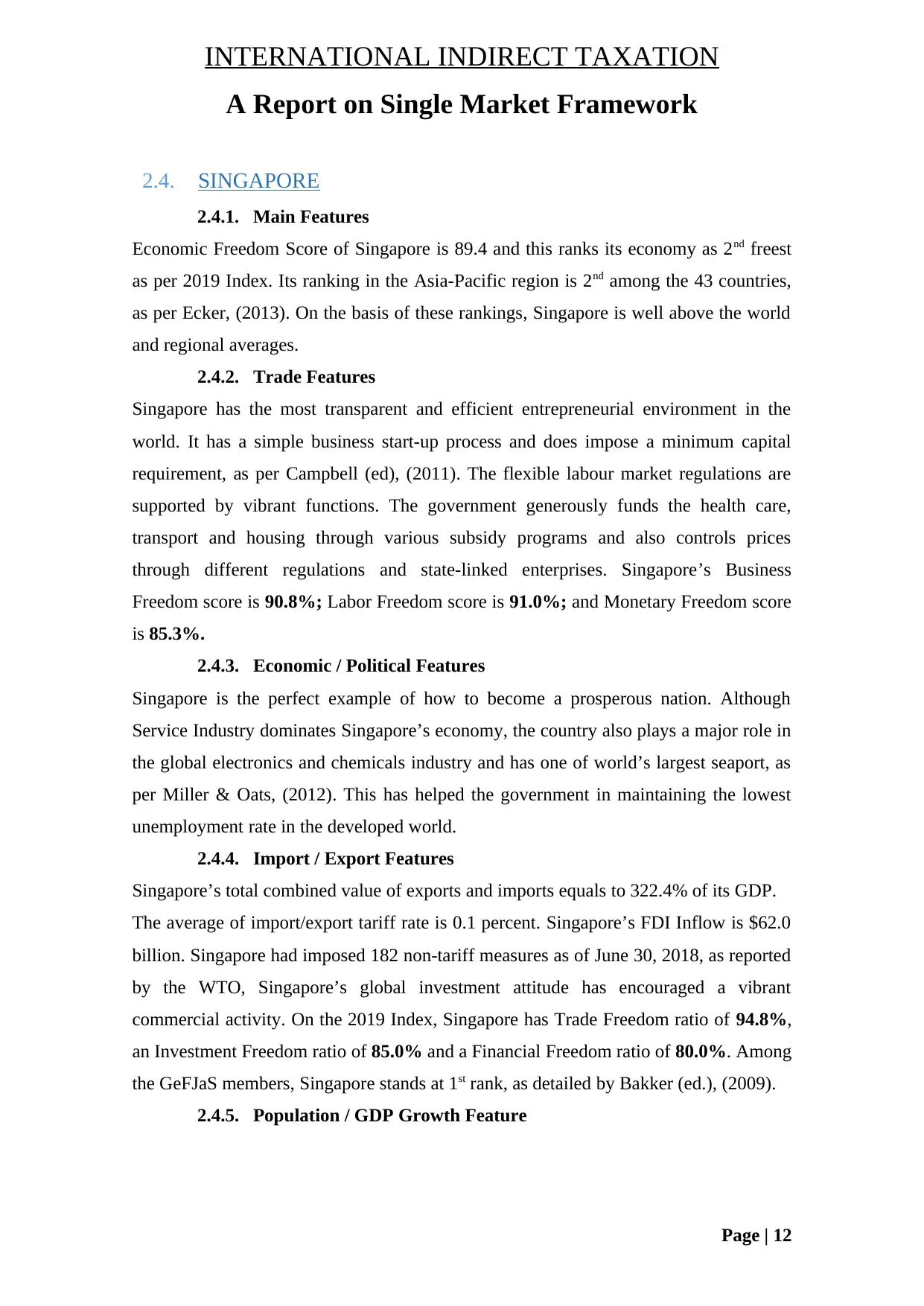
INTERNATIONAL INDIRECT TAXATION
A Report on Single Market Framework
2.4. SINGAPORE
2.4.1. Main Features
Economic Freedom Score of Singapore is 89.4 and this ranks its economy as 2nd freest
as per 2019 Index. Its ranking in the Asia-Pacific region is 2nd among the 43 countries,
as per Ecker, (2013). On the basis of these rankings, Singapore is well above the world
and regional averages.
2.4.2. Trade Features
Singapore has the most transparent and efficient entrepreneurial environment in the
world. It has a simple business start-up process and does impose a minimum capital
requirement, as per Campbell (ed), (2011). The flexible labour market regulations are
supported by vibrant functions. The government generously funds the health care,
transport and housing through various subsidy programs and also controls prices
through different regulations and state-linked enterprises. Singapore’s Business
Freedom score is 90.8%; Labor Freedom score is 91.0%; and Monetary Freedom score
is 85.3%.
2.4.3. Economic / Political Features
Singapore is the perfect example of how to become a prosperous nation. Although
Service Industry dominates Singapore’s economy, the country also plays a major role in
the global electronics and chemicals industry and has one of world’s largest seaport, as
per Miller & Oats, (2012). This has helped the government in maintaining the lowest
unemployment rate in the developed world.
2.4.4. Import / Export Features
Singapore’s total combined value of exports and imports equals to 322.4% of its GDP.
The average of import/export tariff rate is 0.1 percent. Singapore’s FDI Inflow is $62.0
billion. Singapore had imposed 182 non-tariff measures as of June 30, 2018, as reported
by the WTO, Singapore’s global investment attitude has encouraged a vibrant
commercial activity. On the 2019 Index, Singapore has Trade Freedom ratio of 94.8%,
an Investment Freedom ratio of 85.0% and a Financial Freedom ratio of 80.0%. Among
the GeFJaS members, Singapore stands at 1st rank, as detailed by Bakker (ed.), (2009).
2.4.5. Population / GDP Growth Feature
Page | 12
A Report on Single Market Framework
2.4. SINGAPORE
2.4.1. Main Features
Economic Freedom Score of Singapore is 89.4 and this ranks its economy as 2nd freest
as per 2019 Index. Its ranking in the Asia-Pacific region is 2nd among the 43 countries,
as per Ecker, (2013). On the basis of these rankings, Singapore is well above the world
and regional averages.
2.4.2. Trade Features
Singapore has the most transparent and efficient entrepreneurial environment in the
world. It has a simple business start-up process and does impose a minimum capital
requirement, as per Campbell (ed), (2011). The flexible labour market regulations are
supported by vibrant functions. The government generously funds the health care,
transport and housing through various subsidy programs and also controls prices
through different regulations and state-linked enterprises. Singapore’s Business
Freedom score is 90.8%; Labor Freedom score is 91.0%; and Monetary Freedom score
is 85.3%.
2.4.3. Economic / Political Features
Singapore is the perfect example of how to become a prosperous nation. Although
Service Industry dominates Singapore’s economy, the country also plays a major role in
the global electronics and chemicals industry and has one of world’s largest seaport, as
per Miller & Oats, (2012). This has helped the government in maintaining the lowest
unemployment rate in the developed world.
2.4.4. Import / Export Features
Singapore’s total combined value of exports and imports equals to 322.4% of its GDP.
The average of import/export tariff rate is 0.1 percent. Singapore’s FDI Inflow is $62.0
billion. Singapore had imposed 182 non-tariff measures as of June 30, 2018, as reported
by the WTO, Singapore’s global investment attitude has encouraged a vibrant
commercial activity. On the 2019 Index, Singapore has Trade Freedom ratio of 94.8%,
an Investment Freedom ratio of 85.0% and a Financial Freedom ratio of 80.0%. Among
the GeFJaS members, Singapore stands at 1st rank, as detailed by Bakker (ed.), (2009).
2.4.5. Population / GDP Growth Feature
Page | 12
Paraphrase This Document
Need a fresh take? Get an instant paraphrase of this document with our AI Paraphraser
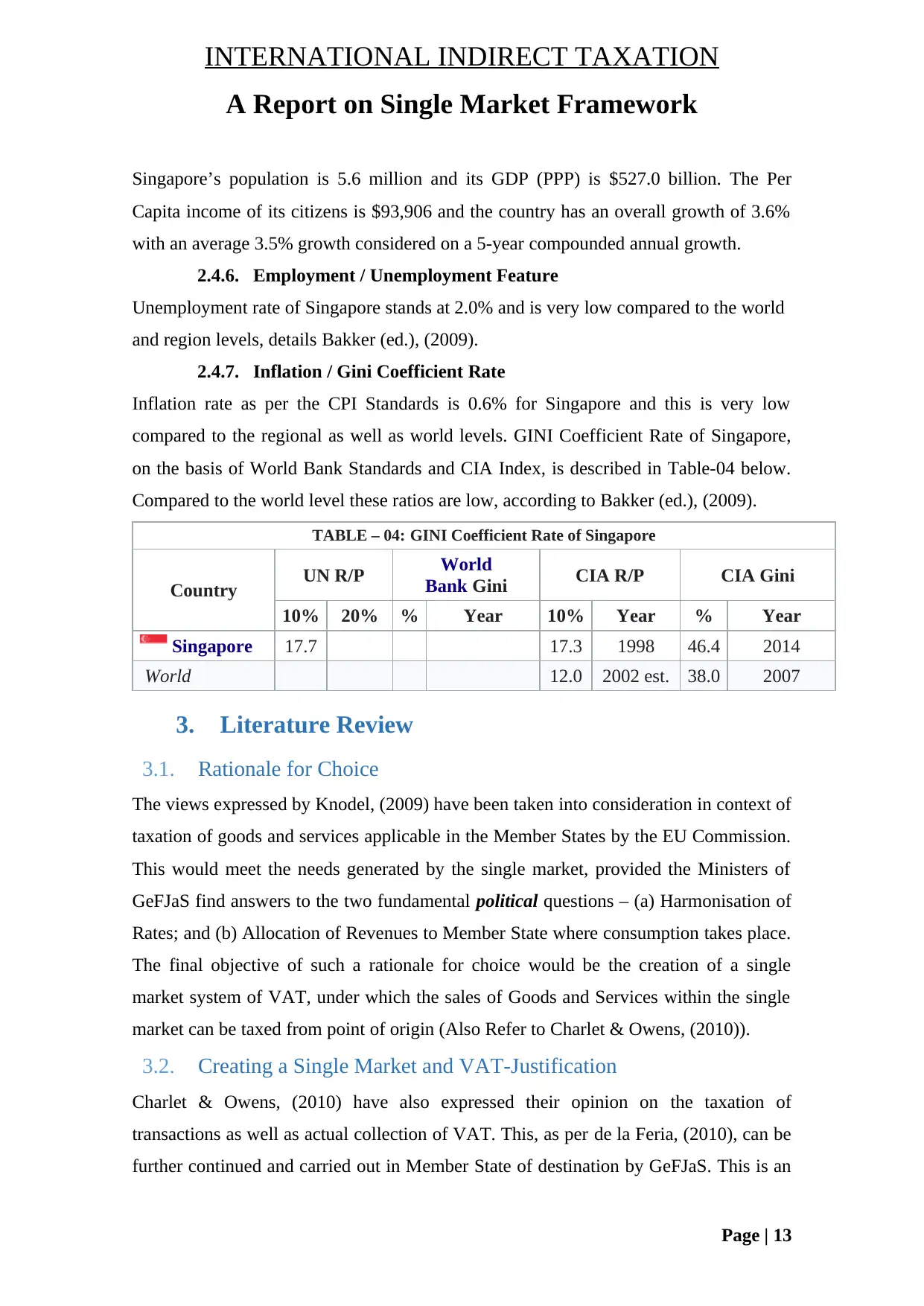
INTERNATIONAL INDIRECT TAXATION
A Report on Single Market Framework
Singapore’s population is 5.6 million and its GDP (PPP) is $527.0 billion. The Per
Capita income of its citizens is $93,906 and the country has an overall growth of 3.6%
with an average 3.5% growth considered on a 5-year compounded annual growth.
2.4.6. Employment / Unemployment Feature
Unemployment rate of Singapore stands at 2.0% and is very low compared to the world
and region levels, details Bakker (ed.), (2009).
2.4.7. Inflation / Gini Coefficient Rate
Inflation rate as per the CPI Standards is 0.6% for Singapore and this is very low
compared to the regional as well as world levels. GINI Coefficient Rate of Singapore,
on the basis of World Bank Standards and CIA Index, is described in Table-04 below.
Compared to the world level these ratios are low, according to Bakker (ed.), (2009).
TABLE – 04: GINI Coefficient Rate of Singapore
Country UN R/P World
Bank Gini CIA R/P CIA Gini
10% 20% % Year 10% Year % Year
Singapore 17.7 17.3 1998 46.4 2014
World 12.0 2002 est. 38.0 2007
3. Literature Review
3.1. Rationale for Choice
The views expressed by Knodel, (2009) have been taken into consideration in context of
taxation of goods and services applicable in the Member States by the EU Commission.
This would meet the needs generated by the single market, provided the Ministers of
GeFJaS find answers to the two fundamental political questions – (a) Harmonisation of
Rates; and (b) Allocation of Revenues to Member State where consumption takes place.
The final objective of such a rationale for choice would be the creation of a single
market system of VAT, under which the sales of Goods and Services within the single
market can be taxed from point of origin (Also Refer to Charlet & Owens, (2010)).
3.2. Creating a Single Market and VAT-Justification
Charlet & Owens, (2010) have also expressed their opinion on the taxation of
transactions as well as actual collection of VAT. This, as per de la Feria, (2010), can be
further continued and carried out in Member State of destination by GeFJaS. This is an
Page | 13
A Report on Single Market Framework
Singapore’s population is 5.6 million and its GDP (PPP) is $527.0 billion. The Per
Capita income of its citizens is $93,906 and the country has an overall growth of 3.6%
with an average 3.5% growth considered on a 5-year compounded annual growth.
2.4.6. Employment / Unemployment Feature
Unemployment rate of Singapore stands at 2.0% and is very low compared to the world
and region levels, details Bakker (ed.), (2009).
2.4.7. Inflation / Gini Coefficient Rate
Inflation rate as per the CPI Standards is 0.6% for Singapore and this is very low
compared to the regional as well as world levels. GINI Coefficient Rate of Singapore,
on the basis of World Bank Standards and CIA Index, is described in Table-04 below.
Compared to the world level these ratios are low, according to Bakker (ed.), (2009).
TABLE – 04: GINI Coefficient Rate of Singapore
Country UN R/P World
Bank Gini CIA R/P CIA Gini
10% 20% % Year 10% Year % Year
Singapore 17.7 17.3 1998 46.4 2014
World 12.0 2002 est. 38.0 2007
3. Literature Review
3.1. Rationale for Choice
The views expressed by Knodel, (2009) have been taken into consideration in context of
taxation of goods and services applicable in the Member States by the EU Commission.
This would meet the needs generated by the single market, provided the Ministers of
GeFJaS find answers to the two fundamental political questions – (a) Harmonisation of
Rates; and (b) Allocation of Revenues to Member State where consumption takes place.
The final objective of such a rationale for choice would be the creation of a single
market system of VAT, under which the sales of Goods and Services within the single
market can be taxed from point of origin (Also Refer to Charlet & Owens, (2010)).
3.2. Creating a Single Market and VAT-Justification
Charlet & Owens, (2010) have also expressed their opinion on the taxation of
transactions as well as actual collection of VAT. This, as per de la Feria, (2010), can be
further continued and carried out in Member State of destination by GeFJaS. This is an
Page | 13
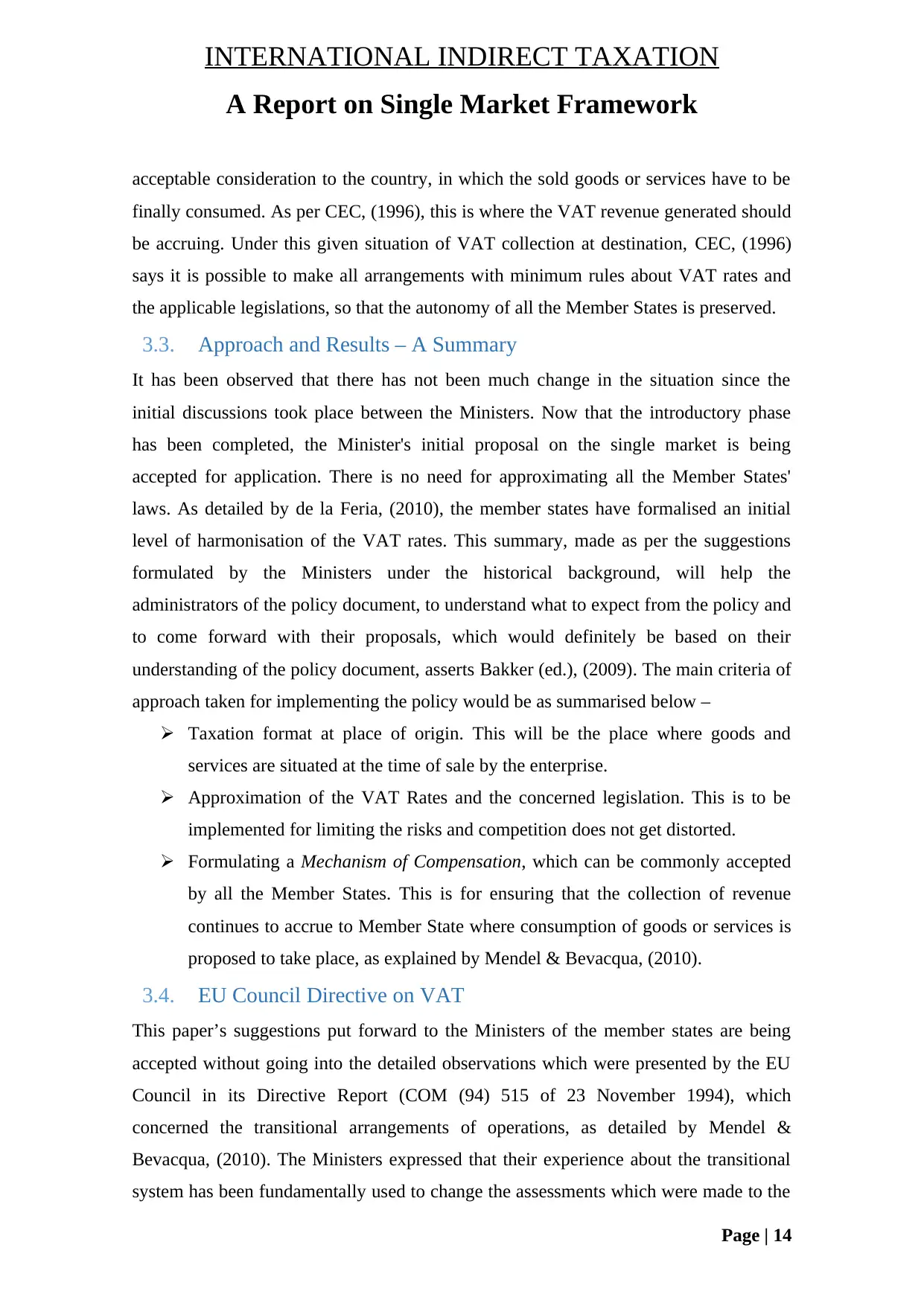
INTERNATIONAL INDIRECT TAXATION
A Report on Single Market Framework
acceptable consideration to the country, in which the sold goods or services have to be
finally consumed. As per CEC, (1996), this is where the VAT revenue generated should
be accruing. Under this given situation of VAT collection at destination, CEC, (1996)
says it is possible to make all arrangements with minimum rules about VAT rates and
the applicable legislations, so that the autonomy of all the Member States is preserved.
3.3. Approach and Results – A Summary
It has been observed that there has not been much change in the situation since the
initial discussions took place between the Ministers. Now that the introductory phase
has been completed, the Minister's initial proposal on the single market is being
accepted for application. There is no need for approximating all the Member States'
laws. As detailed by de la Feria, (2010), the member states have formalised an initial
level of harmonisation of the VAT rates. This summary, made as per the suggestions
formulated by the Ministers under the historical background, will help the
administrators of the policy document, to understand what to expect from the policy and
to come forward with their proposals, which would definitely be based on their
understanding of the policy document, asserts Bakker (ed.), (2009). The main criteria of
approach taken for implementing the policy would be as summarised below –
Taxation format at place of origin. This will be the place where goods and
services are situated at the time of sale by the enterprise.
Approximation of the VAT Rates and the concerned legislation. This is to be
implemented for limiting the risks and competition does not get distorted.
Formulating a Mechanism of Compensation, which can be commonly accepted
by all the Member States. This is for ensuring that the collection of revenue
continues to accrue to Member State where consumption of goods or services is
proposed to take place, as explained by Mendel & Bevacqua, (2010).
3.4. EU Council Directive on VAT
This paper’s suggestions put forward to the Ministers of the member states are being
accepted without going into the detailed observations which were presented by the EU
Council in its Directive Report (COM (94) 515 of 23 November 1994), which
concerned the transitional arrangements of operations, as detailed by Mendel &
Bevacqua, (2010). The Ministers expressed that their experience about the transitional
system has been fundamentally used to change the assessments which were made to the
Page | 14
A Report on Single Market Framework
acceptable consideration to the country, in which the sold goods or services have to be
finally consumed. As per CEC, (1996), this is where the VAT revenue generated should
be accruing. Under this given situation of VAT collection at destination, CEC, (1996)
says it is possible to make all arrangements with minimum rules about VAT rates and
the applicable legislations, so that the autonomy of all the Member States is preserved.
3.3. Approach and Results – A Summary
It has been observed that there has not been much change in the situation since the
initial discussions took place between the Ministers. Now that the introductory phase
has been completed, the Minister's initial proposal on the single market is being
accepted for application. There is no need for approximating all the Member States'
laws. As detailed by de la Feria, (2010), the member states have formalised an initial
level of harmonisation of the VAT rates. This summary, made as per the suggestions
formulated by the Ministers under the historical background, will help the
administrators of the policy document, to understand what to expect from the policy and
to come forward with their proposals, which would definitely be based on their
understanding of the policy document, asserts Bakker (ed.), (2009). The main criteria of
approach taken for implementing the policy would be as summarised below –
Taxation format at place of origin. This will be the place where goods and
services are situated at the time of sale by the enterprise.
Approximation of the VAT Rates and the concerned legislation. This is to be
implemented for limiting the risks and competition does not get distorted.
Formulating a Mechanism of Compensation, which can be commonly accepted
by all the Member States. This is for ensuring that the collection of revenue
continues to accrue to Member State where consumption of goods or services is
proposed to take place, as explained by Mendel & Bevacqua, (2010).
3.4. EU Council Directive on VAT
This paper’s suggestions put forward to the Ministers of the member states are being
accepted without going into the detailed observations which were presented by the EU
Council in its Directive Report (COM (94) 515 of 23 November 1994), which
concerned the transitional arrangements of operations, as detailed by Mendel &
Bevacqua, (2010). The Ministers expressed that their experience about the transitional
system has been fundamentally used to change the assessments which were made to the
Page | 14
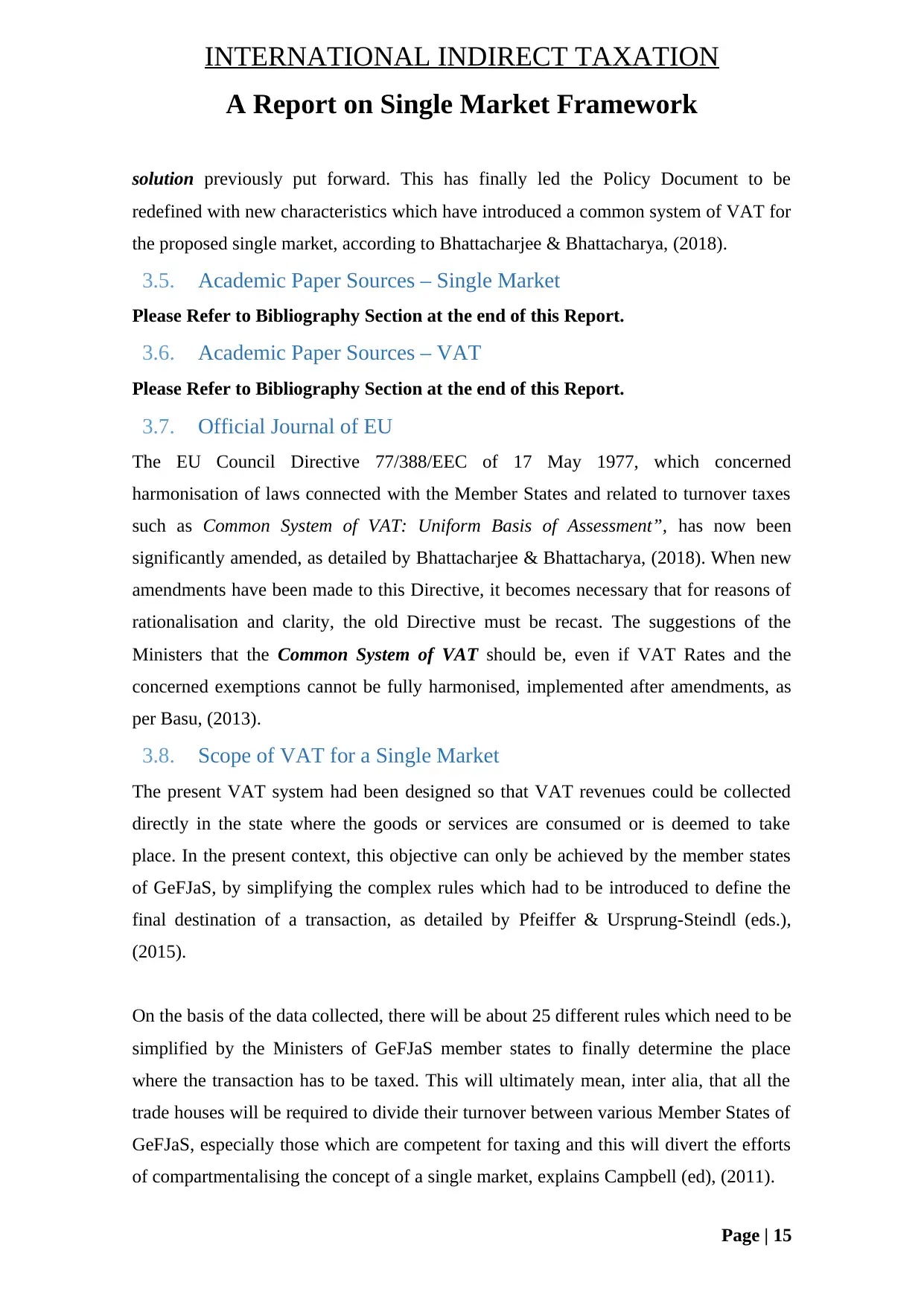
INTERNATIONAL INDIRECT TAXATION
A Report on Single Market Framework
solution previously put forward. This has finally led the Policy Document to be
redefined with new characteristics which have introduced a common system of VAT for
the proposed single market, according to Bhattacharjee & Bhattacharya, (2018).
3.5. Academic Paper Sources – Single Market
Please Refer to Bibliography Section at the end of this Report.
3.6. Academic Paper Sources – VAT
Please Refer to Bibliography Section at the end of this Report.
3.7. Official Journal of EU
The EU Council Directive 77/388/EEC of 17 May 1977, which concerned
harmonisation of laws connected with the Member States and related to turnover taxes
such as Common System of VAT: Uniform Basis of Assessment”, has now been
significantly amended, as detailed by Bhattacharjee & Bhattacharya, (2018). When new
amendments have been made to this Directive, it becomes necessary that for reasons of
rationalisation and clarity, the old Directive must be recast. The suggestions of the
Ministers that the Common System of VAT should be, even if VAT Rates and the
concerned exemptions cannot be fully harmonised, implemented after amendments, as
per Basu, (2013).
3.8. Scope of VAT for a Single Market
The present VAT system had been designed so that VAT revenues could be collected
directly in the state where the goods or services are consumed or is deemed to take
place. In the present context, this objective can only be achieved by the member states
of GeFJaS, by simplifying the complex rules which had to be introduced to define the
final destination of a transaction, as detailed by Pfeiffer & Ursprung-Steindl (eds.),
(2015).
On the basis of the data collected, there will be about 25 different rules which need to be
simplified by the Ministers of GeFJaS member states to finally determine the place
where the transaction has to be taxed. This will ultimately mean, inter alia, that all the
trade houses will be required to divide their turnover between various Member States of
GeFJaS, especially those which are competent for taxing and this will divert the efforts
of compartmentalising the concept of a single market, explains Campbell (ed), (2011).
Page | 15
A Report on Single Market Framework
solution previously put forward. This has finally led the Policy Document to be
redefined with new characteristics which have introduced a common system of VAT for
the proposed single market, according to Bhattacharjee & Bhattacharya, (2018).
3.5. Academic Paper Sources – Single Market
Please Refer to Bibliography Section at the end of this Report.
3.6. Academic Paper Sources – VAT
Please Refer to Bibliography Section at the end of this Report.
3.7. Official Journal of EU
The EU Council Directive 77/388/EEC of 17 May 1977, which concerned
harmonisation of laws connected with the Member States and related to turnover taxes
such as Common System of VAT: Uniform Basis of Assessment”, has now been
significantly amended, as detailed by Bhattacharjee & Bhattacharya, (2018). When new
amendments have been made to this Directive, it becomes necessary that for reasons of
rationalisation and clarity, the old Directive must be recast. The suggestions of the
Ministers that the Common System of VAT should be, even if VAT Rates and the
concerned exemptions cannot be fully harmonised, implemented after amendments, as
per Basu, (2013).
3.8. Scope of VAT for a Single Market
The present VAT system had been designed so that VAT revenues could be collected
directly in the state where the goods or services are consumed or is deemed to take
place. In the present context, this objective can only be achieved by the member states
of GeFJaS, by simplifying the complex rules which had to be introduced to define the
final destination of a transaction, as detailed by Pfeiffer & Ursprung-Steindl (eds.),
(2015).
On the basis of the data collected, there will be about 25 different rules which need to be
simplified by the Ministers of GeFJaS member states to finally determine the place
where the transaction has to be taxed. This will ultimately mean, inter alia, that all the
trade houses will be required to divide their turnover between various Member States of
GeFJaS, especially those which are competent for taxing and this will divert the efforts
of compartmentalising the concept of a single market, explains Campbell (ed), (2011).
Page | 15
Secure Best Marks with AI Grader
Need help grading? Try our AI Grader for instant feedback on your assignments.
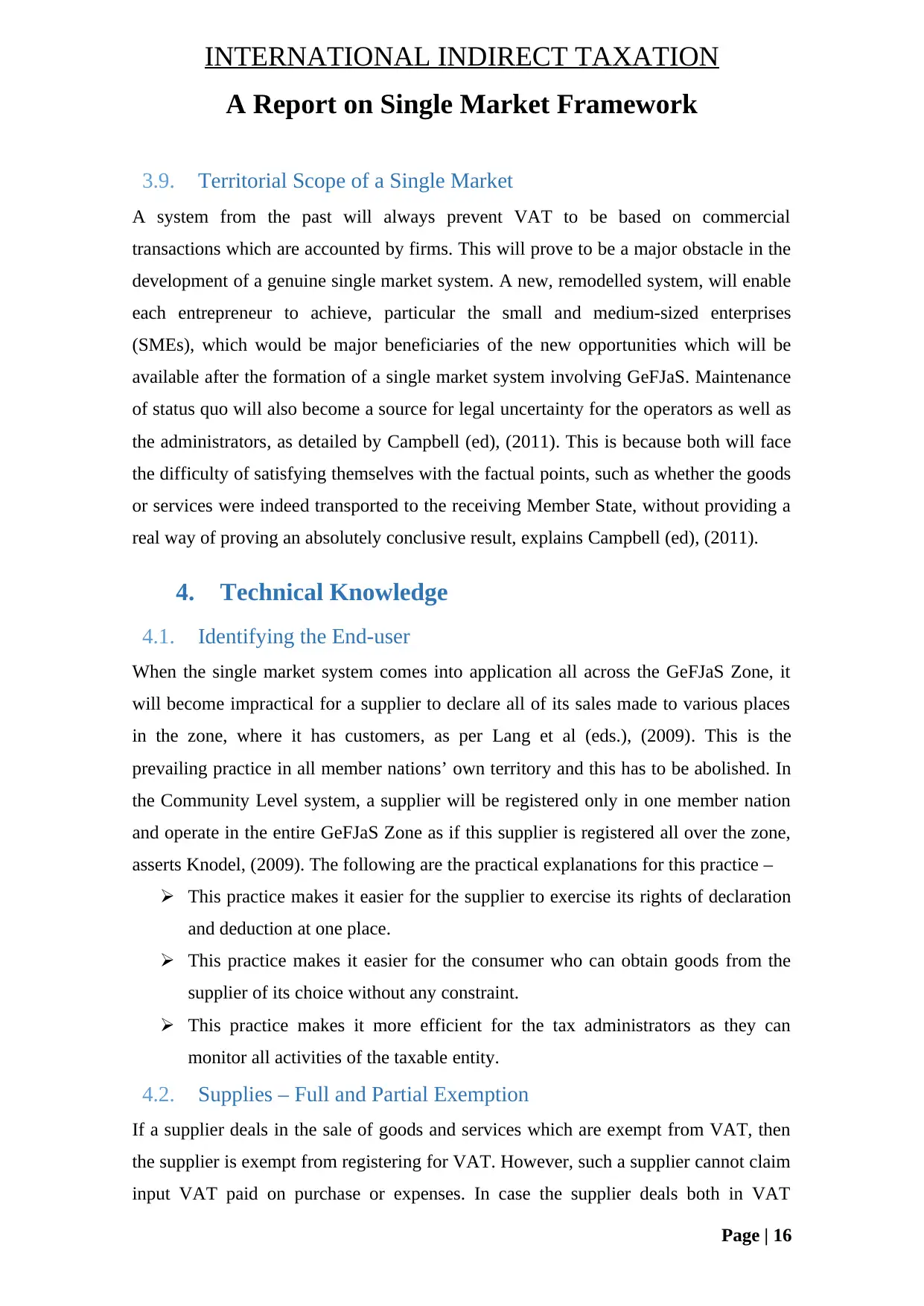
INTERNATIONAL INDIRECT TAXATION
A Report on Single Market Framework
3.9. Territorial Scope of a Single Market
A system from the past will always prevent VAT to be based on commercial
transactions which are accounted by firms. This will prove to be a major obstacle in the
development of a genuine single market system. A new, remodelled system, will enable
each entrepreneur to achieve, particular the small and medium-sized enterprises
(SMEs), which would be major beneficiaries of the new opportunities which will be
available after the formation of a single market system involving GeFJaS. Maintenance
of status quo will also become a source for legal uncertainty for the operators as well as
the administrators, as detailed by Campbell (ed), (2011). This is because both will face
the difficulty of satisfying themselves with the factual points, such as whether the goods
or services were indeed transported to the receiving Member State, without providing a
real way of proving an absolutely conclusive result, explains Campbell (ed), (2011).
4. Technical Knowledge
4.1. Identifying the End-user
When the single market system comes into application all across the GeFJaS Zone, it
will become impractical for a supplier to declare all of its sales made to various places
in the zone, where it has customers, as per Lang et al (eds.), (2009). This is the
prevailing practice in all member nations’ own territory and this has to be abolished. In
the Community Level system, a supplier will be registered only in one member nation
and operate in the entire GeFJaS Zone as if this supplier is registered all over the zone,
asserts Knodel, (2009). The following are the practical explanations for this practice –
This practice makes it easier for the supplier to exercise its rights of declaration
and deduction at one place.
This practice makes it easier for the consumer who can obtain goods from the
supplier of its choice without any constraint.
This practice makes it more efficient for the tax administrators as they can
monitor all activities of the taxable entity.
4.2. Supplies – Full and Partial Exemption
If a supplier deals in the sale of goods and services which are exempt from VAT, then
the supplier is exempt from registering for VAT. However, such a supplier cannot claim
input VAT paid on purchase or expenses. In case the supplier deals both in VAT
Page | 16
A Report on Single Market Framework
3.9. Territorial Scope of a Single Market
A system from the past will always prevent VAT to be based on commercial
transactions which are accounted by firms. This will prove to be a major obstacle in the
development of a genuine single market system. A new, remodelled system, will enable
each entrepreneur to achieve, particular the small and medium-sized enterprises
(SMEs), which would be major beneficiaries of the new opportunities which will be
available after the formation of a single market system involving GeFJaS. Maintenance
of status quo will also become a source for legal uncertainty for the operators as well as
the administrators, as detailed by Campbell (ed), (2011). This is because both will face
the difficulty of satisfying themselves with the factual points, such as whether the goods
or services were indeed transported to the receiving Member State, without providing a
real way of proving an absolutely conclusive result, explains Campbell (ed), (2011).
4. Technical Knowledge
4.1. Identifying the End-user
When the single market system comes into application all across the GeFJaS Zone, it
will become impractical for a supplier to declare all of its sales made to various places
in the zone, where it has customers, as per Lang et al (eds.), (2009). This is the
prevailing practice in all member nations’ own territory and this has to be abolished. In
the Community Level system, a supplier will be registered only in one member nation
and operate in the entire GeFJaS Zone as if this supplier is registered all over the zone,
asserts Knodel, (2009). The following are the practical explanations for this practice –
This practice makes it easier for the supplier to exercise its rights of declaration
and deduction at one place.
This practice makes it easier for the consumer who can obtain goods from the
supplier of its choice without any constraint.
This practice makes it more efficient for the tax administrators as they can
monitor all activities of the taxable entity.
4.2. Supplies – Full and Partial Exemption
If a supplier deals in the sale of goods and services which are exempt from VAT, then
the supplier is exempt from registering for VAT. However, such a supplier cannot claim
input VAT paid on purchase or expenses. In case the supplier deals both in VAT
Page | 16
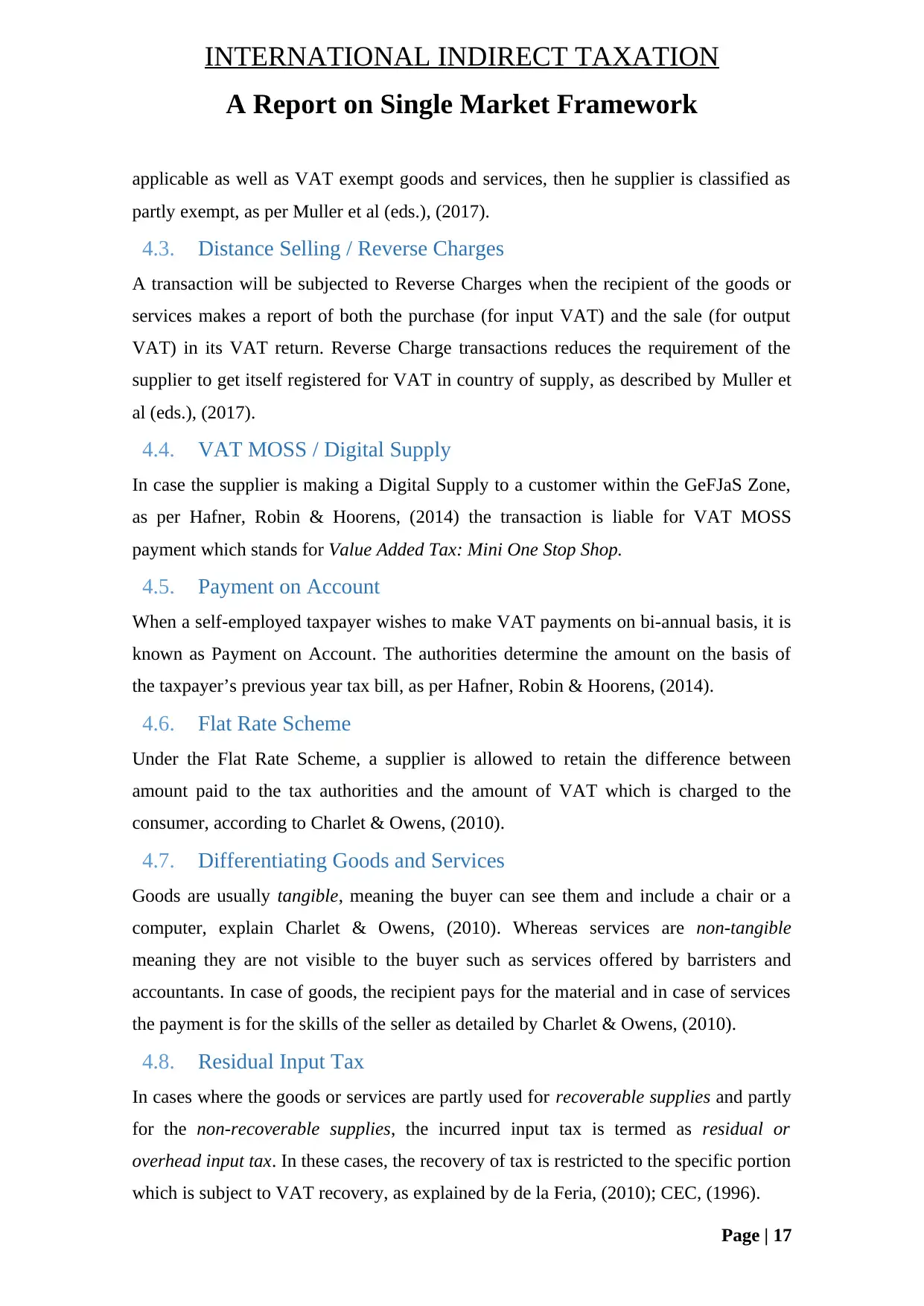
INTERNATIONAL INDIRECT TAXATION
A Report on Single Market Framework
applicable as well as VAT exempt goods and services, then he supplier is classified as
partly exempt, as per Muller et al (eds.), (2017).
4.3. Distance Selling / Reverse Charges
A transaction will be subjected to Reverse Charges when the recipient of the goods or
services makes a report of both the purchase (for input VAT) and the sale (for output
VAT) in its VAT return. Reverse Charge transactions reduces the requirement of the
supplier to get itself registered for VAT in country of supply, as described by Muller et
al (eds.), (2017).
4.4. VAT MOSS / Digital Supply
In case the supplier is making a Digital Supply to a customer within the GeFJaS Zone,
as per Hafner, Robin & Hoorens, (2014) the transaction is liable for VAT MOSS
payment which stands for Value Added Tax: Mini One Stop Shop.
4.5. Payment on Account
When a self-employed taxpayer wishes to make VAT payments on bi-annual basis, it is
known as Payment on Account. The authorities determine the amount on the basis of
the taxpayer’s previous year tax bill, as per Hafner, Robin & Hoorens, (2014).
4.6. Flat Rate Scheme
Under the Flat Rate Scheme, a supplier is allowed to retain the difference between
amount paid to the tax authorities and the amount of VAT which is charged to the
consumer, according to Charlet & Owens, (2010).
4.7. Differentiating Goods and Services
Goods are usually tangible, meaning the buyer can see them and include a chair or a
computer, explain Charlet & Owens, (2010). Whereas services are non-tangible
meaning they are not visible to the buyer such as services offered by barristers and
accountants. In case of goods, the recipient pays for the material and in case of services
the payment is for the skills of the seller as detailed by Charlet & Owens, (2010).
4.8. Residual Input Tax
In cases where the goods or services are partly used for recoverable supplies and partly
for the non-recoverable supplies, the incurred input tax is termed as residual or
overhead input tax. In these cases, the recovery of tax is restricted to the specific portion
which is subject to VAT recovery, as explained by de la Feria, (2010); CEC, (1996).
Page | 17
A Report on Single Market Framework
applicable as well as VAT exempt goods and services, then he supplier is classified as
partly exempt, as per Muller et al (eds.), (2017).
4.3. Distance Selling / Reverse Charges
A transaction will be subjected to Reverse Charges when the recipient of the goods or
services makes a report of both the purchase (for input VAT) and the sale (for output
VAT) in its VAT return. Reverse Charge transactions reduces the requirement of the
supplier to get itself registered for VAT in country of supply, as described by Muller et
al (eds.), (2017).
4.4. VAT MOSS / Digital Supply
In case the supplier is making a Digital Supply to a customer within the GeFJaS Zone,
as per Hafner, Robin & Hoorens, (2014) the transaction is liable for VAT MOSS
payment which stands for Value Added Tax: Mini One Stop Shop.
4.5. Payment on Account
When a self-employed taxpayer wishes to make VAT payments on bi-annual basis, it is
known as Payment on Account. The authorities determine the amount on the basis of
the taxpayer’s previous year tax bill, as per Hafner, Robin & Hoorens, (2014).
4.6. Flat Rate Scheme
Under the Flat Rate Scheme, a supplier is allowed to retain the difference between
amount paid to the tax authorities and the amount of VAT which is charged to the
consumer, according to Charlet & Owens, (2010).
4.7. Differentiating Goods and Services
Goods are usually tangible, meaning the buyer can see them and include a chair or a
computer, explain Charlet & Owens, (2010). Whereas services are non-tangible
meaning they are not visible to the buyer such as services offered by barristers and
accountants. In case of goods, the recipient pays for the material and in case of services
the payment is for the skills of the seller as detailed by Charlet & Owens, (2010).
4.8. Residual Input Tax
In cases where the goods or services are partly used for recoverable supplies and partly
for the non-recoverable supplies, the incurred input tax is termed as residual or
overhead input tax. In these cases, the recovery of tax is restricted to the specific portion
which is subject to VAT recovery, as explained by de la Feria, (2010); CEC, (1996).
Page | 17
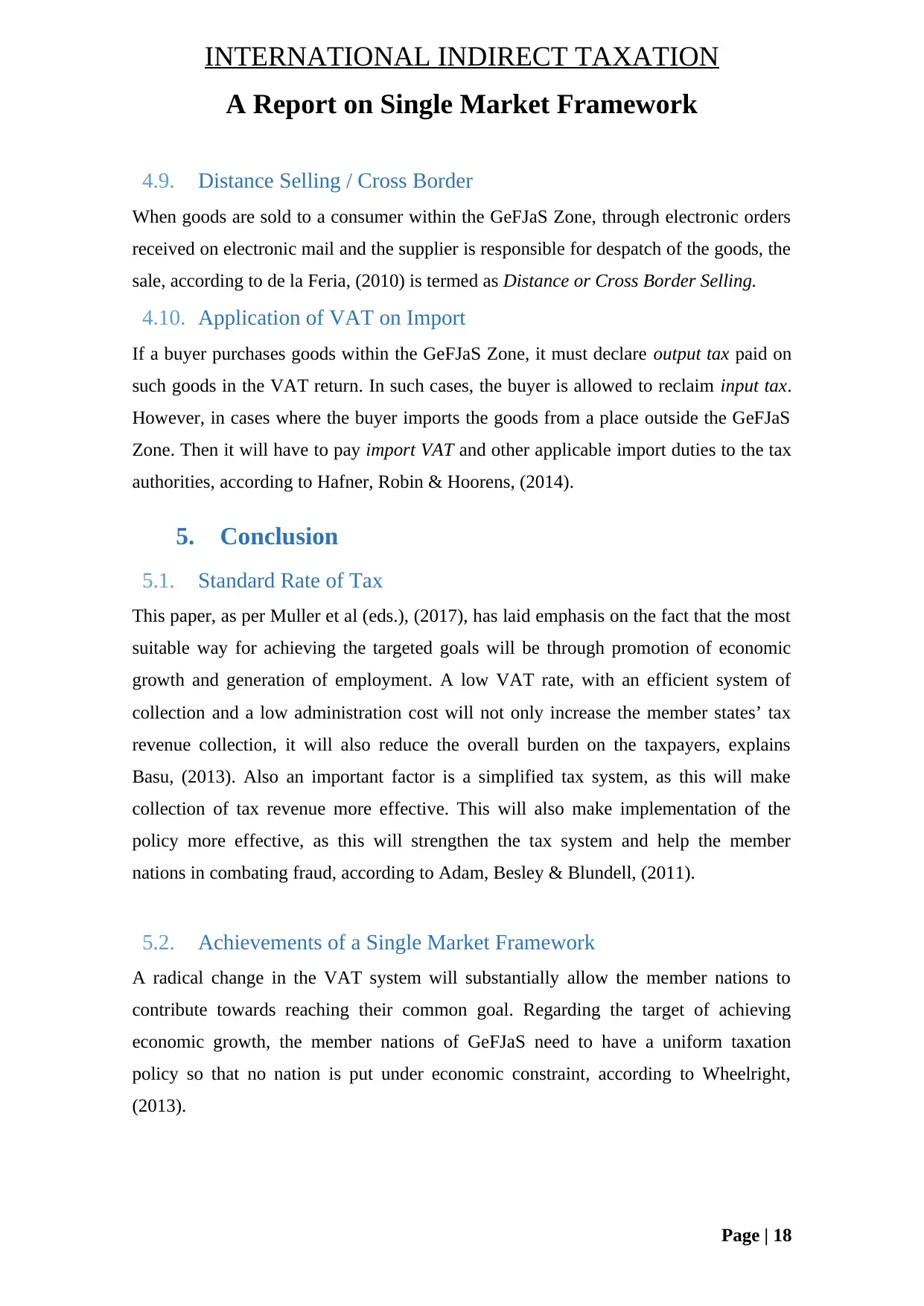
INTERNATIONAL INDIRECT TAXATION
A Report on Single Market Framework
4.9. Distance Selling / Cross Border
When goods are sold to a consumer within the GeFJaS Zone, through electronic orders
received on electronic mail and the supplier is responsible for despatch of the goods, the
sale, according to de la Feria, (2010) is termed as Distance or Cross Border Selling.
4.10. Application of VAT on Import
If a buyer purchases goods within the GeFJaS Zone, it must declare output tax paid on
such goods in the VAT return. In such cases, the buyer is allowed to reclaim input tax.
However, in cases where the buyer imports the goods from a place outside the GeFJaS
Zone. Then it will have to pay import VAT and other applicable import duties to the tax
authorities, according to Hafner, Robin & Hoorens, (2014).
5. Conclusion
5.1. Standard Rate of Tax
This paper, as per Muller et al (eds.), (2017), has laid emphasis on the fact that the most
suitable way for achieving the targeted goals will be through promotion of economic
growth and generation of employment. A low VAT rate, with an efficient system of
collection and a low administration cost will not only increase the member states’ tax
revenue collection, it will also reduce the overall burden on the taxpayers, explains
Basu, (2013). Also an important factor is a simplified tax system, as this will make
collection of tax revenue more effective. This will also make implementation of the
policy more effective, as this will strengthen the tax system and help the member
nations in combating fraud, according to Adam, Besley & Blundell, (2011).
5.2. Achievements of a Single Market Framework
A radical change in the VAT system will substantially allow the member nations to
contribute towards reaching their common goal. Regarding the target of achieving
economic growth, the member nations of GeFJaS need to have a uniform taxation
policy so that no nation is put under economic constraint, according to Wheelright,
(2013).
Page | 18
A Report on Single Market Framework
4.9. Distance Selling / Cross Border
When goods are sold to a consumer within the GeFJaS Zone, through electronic orders
received on electronic mail and the supplier is responsible for despatch of the goods, the
sale, according to de la Feria, (2010) is termed as Distance or Cross Border Selling.
4.10. Application of VAT on Import
If a buyer purchases goods within the GeFJaS Zone, it must declare output tax paid on
such goods in the VAT return. In such cases, the buyer is allowed to reclaim input tax.
However, in cases where the buyer imports the goods from a place outside the GeFJaS
Zone. Then it will have to pay import VAT and other applicable import duties to the tax
authorities, according to Hafner, Robin & Hoorens, (2014).
5. Conclusion
5.1. Standard Rate of Tax
This paper, as per Muller et al (eds.), (2017), has laid emphasis on the fact that the most
suitable way for achieving the targeted goals will be through promotion of economic
growth and generation of employment. A low VAT rate, with an efficient system of
collection and a low administration cost will not only increase the member states’ tax
revenue collection, it will also reduce the overall burden on the taxpayers, explains
Basu, (2013). Also an important factor is a simplified tax system, as this will make
collection of tax revenue more effective. This will also make implementation of the
policy more effective, as this will strengthen the tax system and help the member
nations in combating fraud, according to Adam, Besley & Blundell, (2011).
5.2. Achievements of a Single Market Framework
A radical change in the VAT system will substantially allow the member nations to
contribute towards reaching their common goal. Regarding the target of achieving
economic growth, the member nations of GeFJaS need to have a uniform taxation
policy so that no nation is put under economic constraint, according to Wheelright,
(2013).
Page | 18
Paraphrase This Document
Need a fresh take? Get an instant paraphrase of this document with our AI Paraphraser
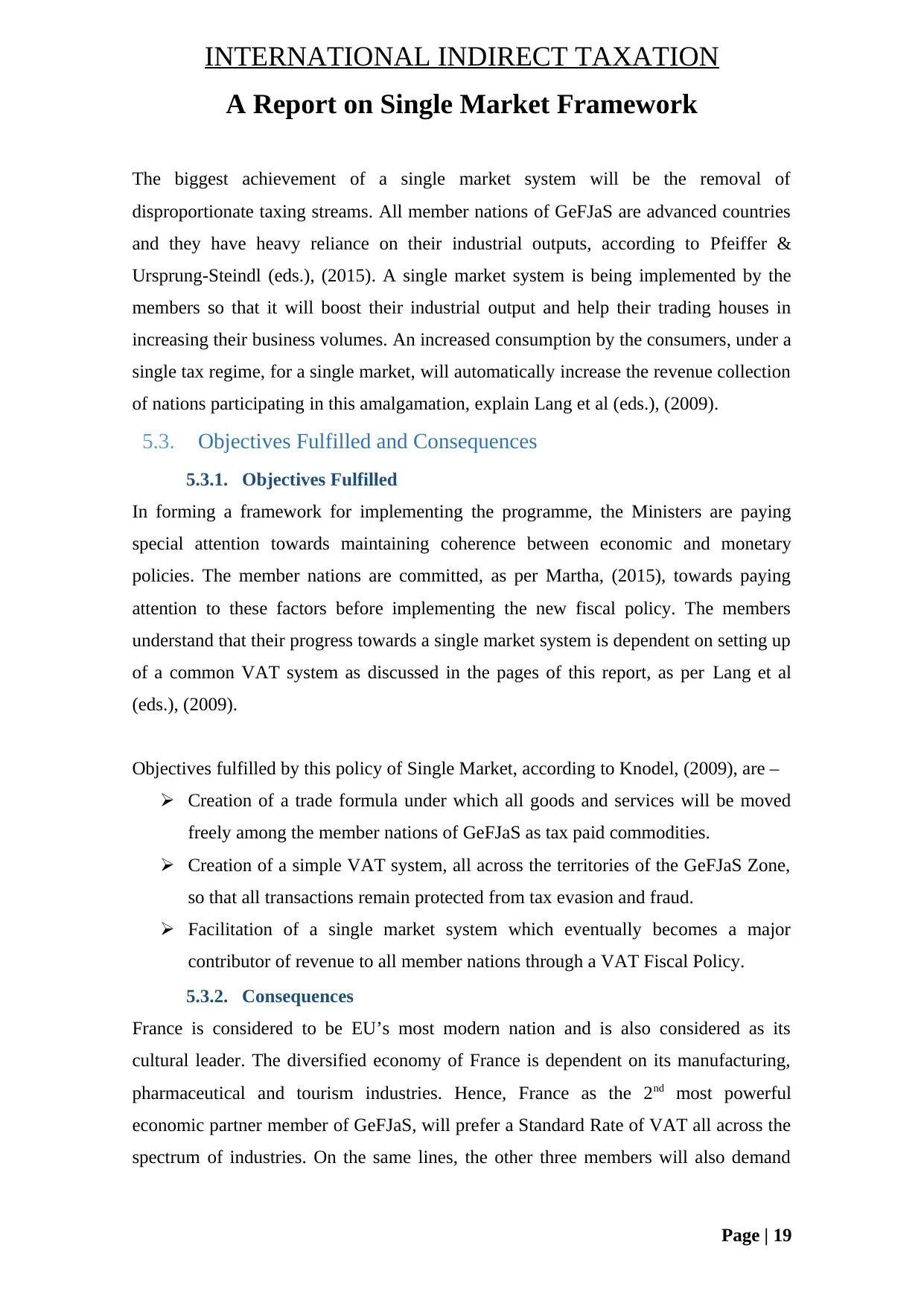
INTERNATIONAL INDIRECT TAXATION
A Report on Single Market Framework
The biggest achievement of a single market system will be the removal of
disproportionate taxing streams. All member nations of GeFJaS are advanced countries
and they have heavy reliance on their industrial outputs, according to Pfeiffer &
Ursprung-Steindl (eds.), (2015). A single market system is being implemented by the
members so that it will boost their industrial output and help their trading houses in
increasing their business volumes. An increased consumption by the consumers, under a
single tax regime, for a single market, will automatically increase the revenue collection
of nations participating in this amalgamation, explain Lang et al (eds.), (2009).
5.3. Objectives Fulfilled and Consequences
5.3.1. Objectives Fulfilled
In forming a framework for implementing the programme, the Ministers are paying
special attention towards maintaining coherence between economic and monetary
policies. The member nations are committed, as per Martha, (2015), towards paying
attention to these factors before implementing the new fiscal policy. The members
understand that their progress towards a single market system is dependent on setting up
of a common VAT system as discussed in the pages of this report, as per Lang et al
(eds.), (2009).
Objectives fulfilled by this policy of Single Market, according to Knodel, (2009), are –
Creation of a trade formula under which all goods and services will be moved
freely among the member nations of GeFJaS as tax paid commodities.
Creation of a simple VAT system, all across the territories of the GeFJaS Zone,
so that all transactions remain protected from tax evasion and fraud.
Facilitation of a single market system which eventually becomes a major
contributor of revenue to all member nations through a VAT Fiscal Policy.
5.3.2. Consequences
France is considered to be EU’s most modern nation and is also considered as its
cultural leader. The diversified economy of France is dependent on its manufacturing,
pharmaceutical and tourism industries. Hence, France as the 2nd most powerful
economic partner member of GeFJaS, will prefer a Standard Rate of VAT all across the
spectrum of industries. On the same lines, the other three members will also demand
Page | 19
A Report on Single Market Framework
The biggest achievement of a single market system will be the removal of
disproportionate taxing streams. All member nations of GeFJaS are advanced countries
and they have heavy reliance on their industrial outputs, according to Pfeiffer &
Ursprung-Steindl (eds.), (2015). A single market system is being implemented by the
members so that it will boost their industrial output and help their trading houses in
increasing their business volumes. An increased consumption by the consumers, under a
single tax regime, for a single market, will automatically increase the revenue collection
of nations participating in this amalgamation, explain Lang et al (eds.), (2009).
5.3. Objectives Fulfilled and Consequences
5.3.1. Objectives Fulfilled
In forming a framework for implementing the programme, the Ministers are paying
special attention towards maintaining coherence between economic and monetary
policies. The member nations are committed, as per Martha, (2015), towards paying
attention to these factors before implementing the new fiscal policy. The members
understand that their progress towards a single market system is dependent on setting up
of a common VAT system as discussed in the pages of this report, as per Lang et al
(eds.), (2009).
Objectives fulfilled by this policy of Single Market, according to Knodel, (2009), are –
Creation of a trade formula under which all goods and services will be moved
freely among the member nations of GeFJaS as tax paid commodities.
Creation of a simple VAT system, all across the territories of the GeFJaS Zone,
so that all transactions remain protected from tax evasion and fraud.
Facilitation of a single market system which eventually becomes a major
contributor of revenue to all member nations through a VAT Fiscal Policy.
5.3.2. Consequences
France is considered to be EU’s most modern nation and is also considered as its
cultural leader. The diversified economy of France is dependent on its manufacturing,
pharmaceutical and tourism industries. Hence, France as the 2nd most powerful
economic partner member of GeFJaS, will prefer a Standard Rate of VAT all across the
spectrum of industries. On the same lines, the other three members will also demand
Page | 19
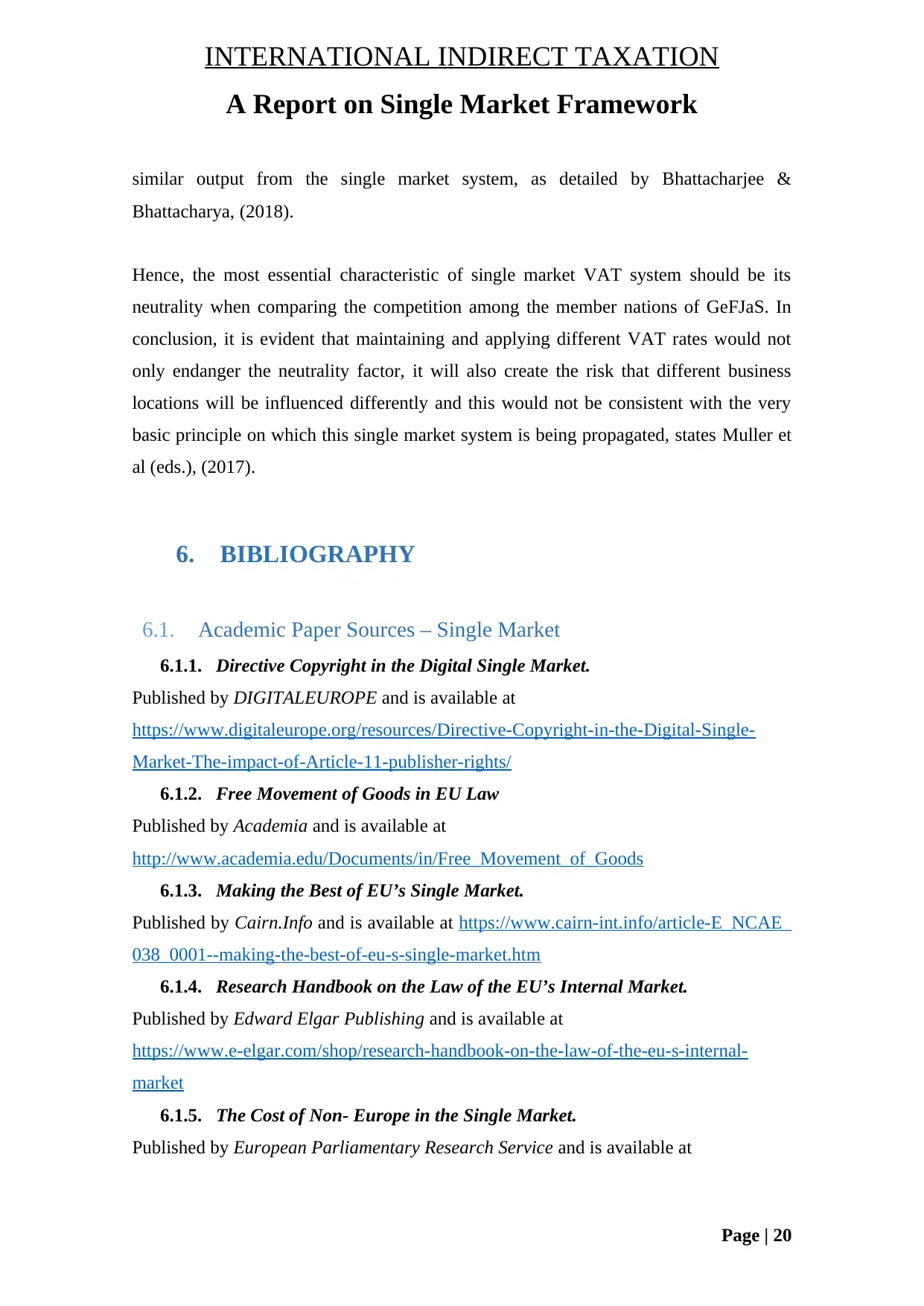
INTERNATIONAL INDIRECT TAXATION
A Report on Single Market Framework
similar output from the single market system, as detailed by Bhattacharjee &
Bhattacharya, (2018).
Hence, the most essential characteristic of single market VAT system should be its
neutrality when comparing the competition among the member nations of GeFJaS. In
conclusion, it is evident that maintaining and applying different VAT rates would not
only endanger the neutrality factor, it will also create the risk that different business
locations will be influenced differently and this would not be consistent with the very
basic principle on which this single market system is being propagated, states Muller et
al (eds.), (2017).
6. BIBLIOGRAPHY
6.1. Academic Paper Sources – Single Market
6.1.1. Directive Copyright in the Digital Single Market.
Published by DIGITALEUROPE and is available at
https://www.digitaleurope.org/resources/Directive-Copyright-in-the-Digital-Single-
Market-The-impact-of-Article-11-publisher-rights/
6.1.2. Free Movement of Goods in EU Law
Published by Academia and is available at
http://www.academia.edu/Documents/in/Free_Movement_of_Goods
6.1.3. Making the Best of EU’s Single Market.
Published by Cairn.Info and is available at https://www.cairn-int.info/article-E_NCAE_
038_0001--making-the-best-of-eu-s-single-market.htm
6.1.4. Research Handbook on the Law of the EU’s Internal Market.
Published by Edward Elgar Publishing and is available at
https://www.e-elgar.com/shop/research-handbook-on-the-law-of-the-eu-s-internal-
market
6.1.5. The Cost of Non- Europe in the Single Market.
Published by European Parliamentary Research Service and is available at
Page | 20
A Report on Single Market Framework
similar output from the single market system, as detailed by Bhattacharjee &
Bhattacharya, (2018).
Hence, the most essential characteristic of single market VAT system should be its
neutrality when comparing the competition among the member nations of GeFJaS. In
conclusion, it is evident that maintaining and applying different VAT rates would not
only endanger the neutrality factor, it will also create the risk that different business
locations will be influenced differently and this would not be consistent with the very
basic principle on which this single market system is being propagated, states Muller et
al (eds.), (2017).
6. BIBLIOGRAPHY
6.1. Academic Paper Sources – Single Market
6.1.1. Directive Copyright in the Digital Single Market.
Published by DIGITALEUROPE and is available at
https://www.digitaleurope.org/resources/Directive-Copyright-in-the-Digital-Single-
Market-The-impact-of-Article-11-publisher-rights/
6.1.2. Free Movement of Goods in EU Law
Published by Academia and is available at
http://www.academia.edu/Documents/in/Free_Movement_of_Goods
6.1.3. Making the Best of EU’s Single Market.
Published by Cairn.Info and is available at https://www.cairn-int.info/article-E_NCAE_
038_0001--making-the-best-of-eu-s-single-market.htm
6.1.4. Research Handbook on the Law of the EU’s Internal Market.
Published by Edward Elgar Publishing and is available at
https://www.e-elgar.com/shop/research-handbook-on-the-law-of-the-eu-s-internal-
market
6.1.5. The Cost of Non- Europe in the Single Market.
Published by European Parliamentary Research Service and is available at
Page | 20
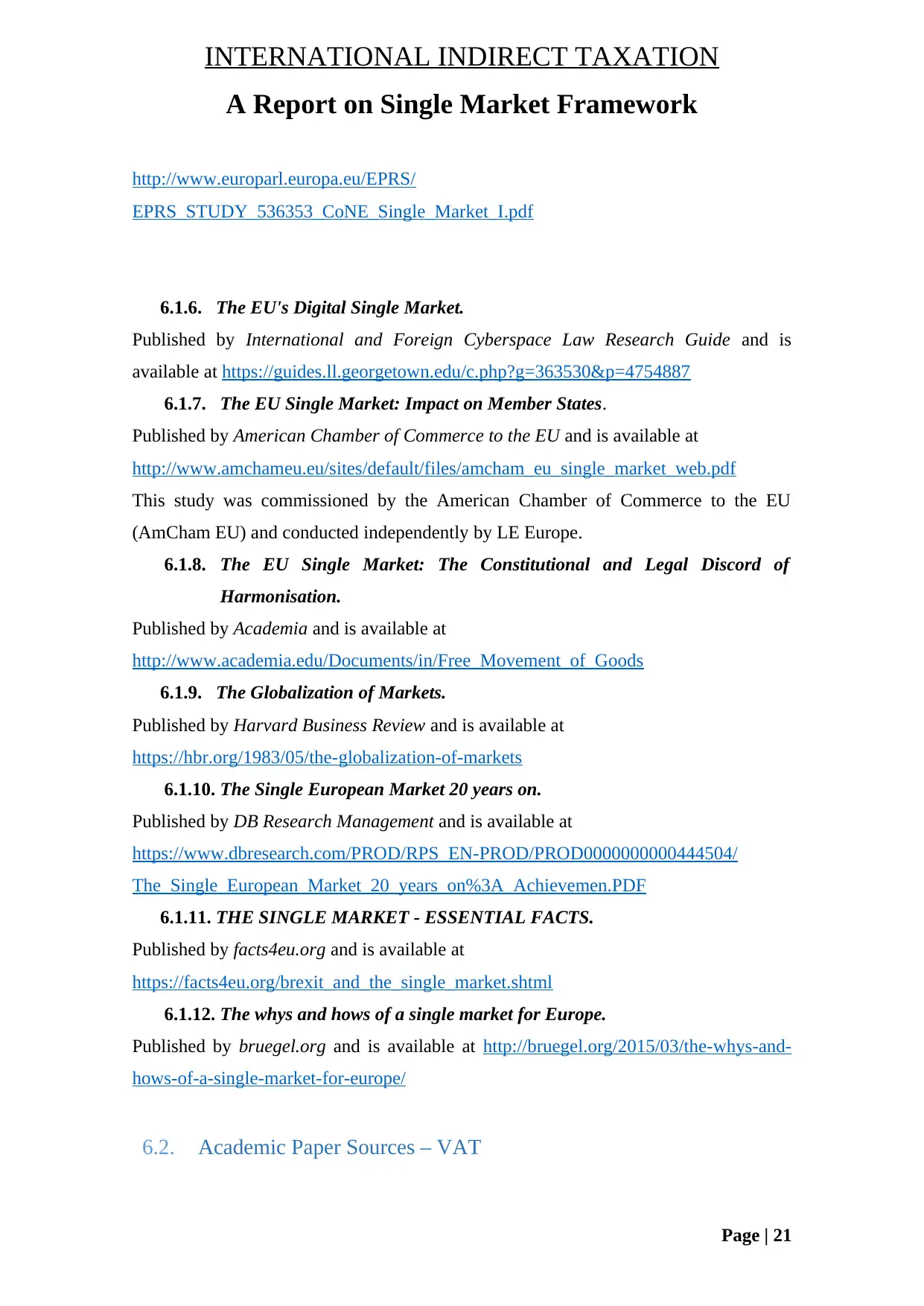
INTERNATIONAL INDIRECT TAXATION
A Report on Single Market Framework
http://www.europarl.europa.eu/EPRS/
EPRS_STUDY_536353_CoNE_Single_Market_I.pdf
6.1.6. The EU's Digital Single Market.
Published by International and Foreign Cyberspace Law Research Guide and is
available at https://guides.ll.georgetown.edu/c.php?g=363530&p=4754887
6.1.7. The EU Single Market: Impact on Member States.
Published by American Chamber of Commerce to the EU and is available at
http://www.amchameu.eu/sites/default/files/amcham_eu_single_market_web.pdf
This study was commissioned by the American Chamber of Commerce to the EU
(AmCham EU) and conducted independently by LE Europe.
6.1.8. The EU Single Market: The Constitutional and Legal Discord of
Harmonisation.
Published by Academia and is available at
http://www.academia.edu/Documents/in/Free_Movement_of_Goods
6.1.9. The Globalization of Markets.
Published by Harvard Business Review and is available at
https://hbr.org/1983/05/the-globalization-of-markets
6.1.10. The Single European Market 20 years on.
Published by DB Research Management and is available at
https://www.dbresearch.com/PROD/RPS_EN-PROD/PROD0000000000444504/
The_Single_European_Market_20_years_on%3A_Achievemen.PDF
6.1.11. THE SINGLE MARKET - ESSENTIAL FACTS.
Published by facts4eu.org and is available at
https://facts4eu.org/brexit_and_the_single_market.shtml
6.1.12. The whys and hows of a single market for Europe.
Published by bruegel.org and is available at http://bruegel.org/2015/03/the-whys-and-
hows-of-a-single-market-for-europe/
6.2. Academic Paper Sources – VAT
Page | 21
A Report on Single Market Framework
http://www.europarl.europa.eu/EPRS/
EPRS_STUDY_536353_CoNE_Single_Market_I.pdf
6.1.6. The EU's Digital Single Market.
Published by International and Foreign Cyberspace Law Research Guide and is
available at https://guides.ll.georgetown.edu/c.php?g=363530&p=4754887
6.1.7. The EU Single Market: Impact on Member States.
Published by American Chamber of Commerce to the EU and is available at
http://www.amchameu.eu/sites/default/files/amcham_eu_single_market_web.pdf
This study was commissioned by the American Chamber of Commerce to the EU
(AmCham EU) and conducted independently by LE Europe.
6.1.8. The EU Single Market: The Constitutional and Legal Discord of
Harmonisation.
Published by Academia and is available at
http://www.academia.edu/Documents/in/Free_Movement_of_Goods
6.1.9. The Globalization of Markets.
Published by Harvard Business Review and is available at
https://hbr.org/1983/05/the-globalization-of-markets
6.1.10. The Single European Market 20 years on.
Published by DB Research Management and is available at
https://www.dbresearch.com/PROD/RPS_EN-PROD/PROD0000000000444504/
The_Single_European_Market_20_years_on%3A_Achievemen.PDF
6.1.11. THE SINGLE MARKET - ESSENTIAL FACTS.
Published by facts4eu.org and is available at
https://facts4eu.org/brexit_and_the_single_market.shtml
6.1.12. The whys and hows of a single market for Europe.
Published by bruegel.org and is available at http://bruegel.org/2015/03/the-whys-and-
hows-of-a-single-market-for-europe/
6.2. Academic Paper Sources – VAT
Page | 21
Secure Best Marks with AI Grader
Need help grading? Try our AI Grader for instant feedback on your assignments.
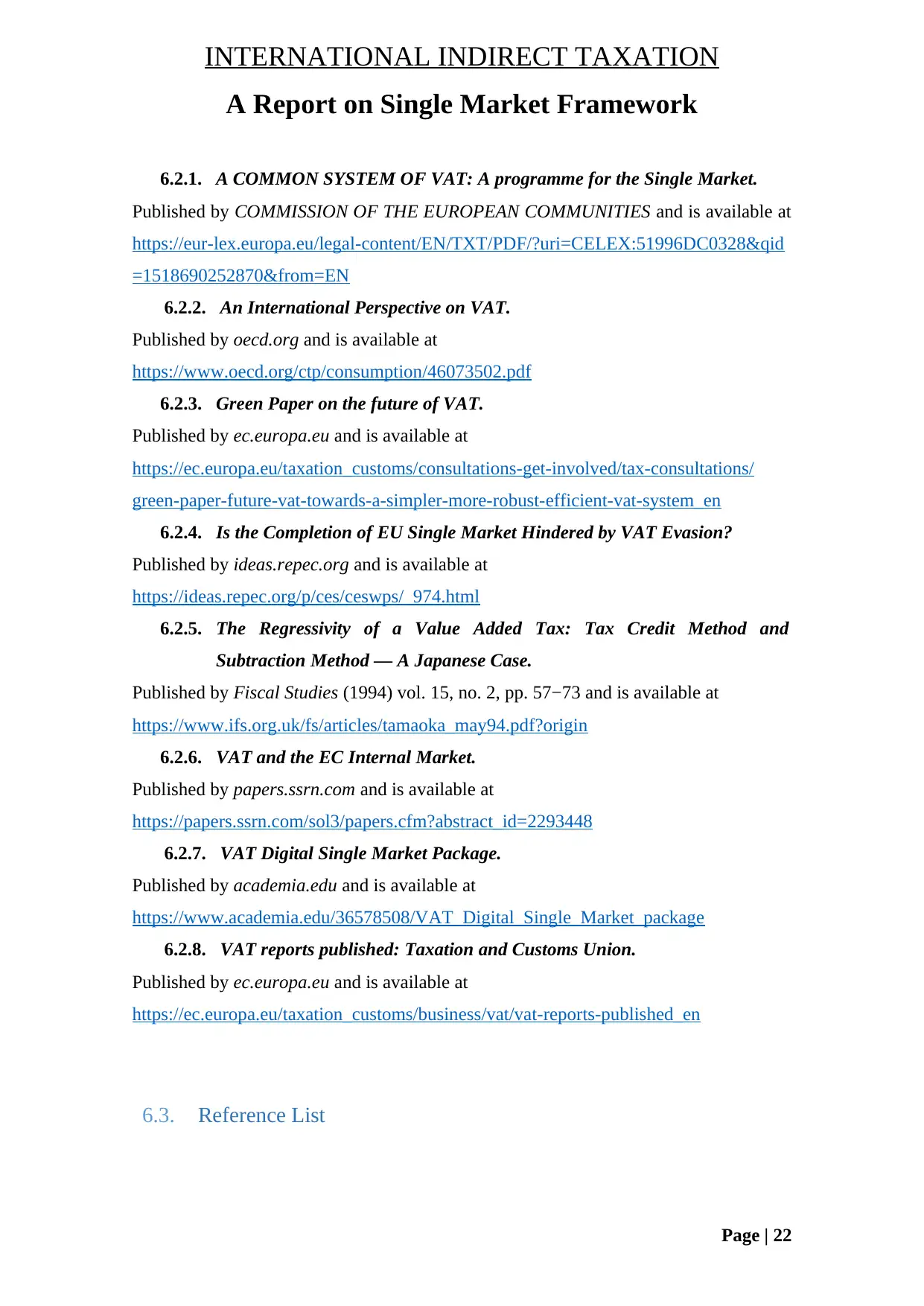
INTERNATIONAL INDIRECT TAXATION
A Report on Single Market Framework
6.2.1. A COMMON SYSTEM OF VAT: A programme for the Single Market.
Published by COMMISSION OF THE EUROPEAN COMMUNITIES and is available at
https://eur-lex.europa.eu/legal-content/EN/TXT/PDF/?uri=CELEX:51996DC0328&qid
=1518690252870&from=EN
6.2.2. An International Perspective on VAT.
Published by oecd.org and is available at
https://www.oecd.org/ctp/consumption/46073502.pdf
6.2.3. Green Paper on the future of VAT.
Published by ec.europa.eu and is available at
https://ec.europa.eu/taxation_customs/consultations-get-involved/tax-consultations/
green-paper-future-vat-towards-a-simpler-more-robust-efficient-vat-system_en
6.2.4. Is the Completion of EU Single Market Hindered by VAT Evasion?
Published by ideas.repec.org and is available at
https://ideas.repec.org/p/ces/ceswps/_974.html
6.2.5. The Regressivity of a Value Added Tax: Tax Credit Method and
Subtraction Method — A Japanese Case.
Published by Fiscal Studies (1994) vol. 15, no. 2, pp. 57−73 and is available at
https://www.ifs.org.uk/fs/articles/tamaoka_may94.pdf?origin
6.2.6. VAT and the EC Internal Market.
Published by papers.ssrn.com and is available at
https://papers.ssrn.com/sol3/papers.cfm?abstract_id=2293448
6.2.7. VAT Digital Single Market Package.
Published by academia.edu and is available at
https://www.academia.edu/36578508/VAT_Digital_Single_Market_package
6.2.8. VAT reports published: Taxation and Customs Union.
Published by ec.europa.eu and is available at
https://ec.europa.eu/taxation_customs/business/vat/vat-reports-published_en
6.3. Reference List
Page | 22
A Report on Single Market Framework
6.2.1. A COMMON SYSTEM OF VAT: A programme for the Single Market.
Published by COMMISSION OF THE EUROPEAN COMMUNITIES and is available at
https://eur-lex.europa.eu/legal-content/EN/TXT/PDF/?uri=CELEX:51996DC0328&qid
=1518690252870&from=EN
6.2.2. An International Perspective on VAT.
Published by oecd.org and is available at
https://www.oecd.org/ctp/consumption/46073502.pdf
6.2.3. Green Paper on the future of VAT.
Published by ec.europa.eu and is available at
https://ec.europa.eu/taxation_customs/consultations-get-involved/tax-consultations/
green-paper-future-vat-towards-a-simpler-more-robust-efficient-vat-system_en
6.2.4. Is the Completion of EU Single Market Hindered by VAT Evasion?
Published by ideas.repec.org and is available at
https://ideas.repec.org/p/ces/ceswps/_974.html
6.2.5. The Regressivity of a Value Added Tax: Tax Credit Method and
Subtraction Method — A Japanese Case.
Published by Fiscal Studies (1994) vol. 15, no. 2, pp. 57−73 and is available at
https://www.ifs.org.uk/fs/articles/tamaoka_may94.pdf?origin
6.2.6. VAT and the EC Internal Market.
Published by papers.ssrn.com and is available at
https://papers.ssrn.com/sol3/papers.cfm?abstract_id=2293448
6.2.7. VAT Digital Single Market Package.
Published by academia.edu and is available at
https://www.academia.edu/36578508/VAT_Digital_Single_Market_package
6.2.8. VAT reports published: Taxation and Customs Union.
Published by ec.europa.eu and is available at
https://ec.europa.eu/taxation_customs/business/vat/vat-reports-published_en
6.3. Reference List
Page | 22
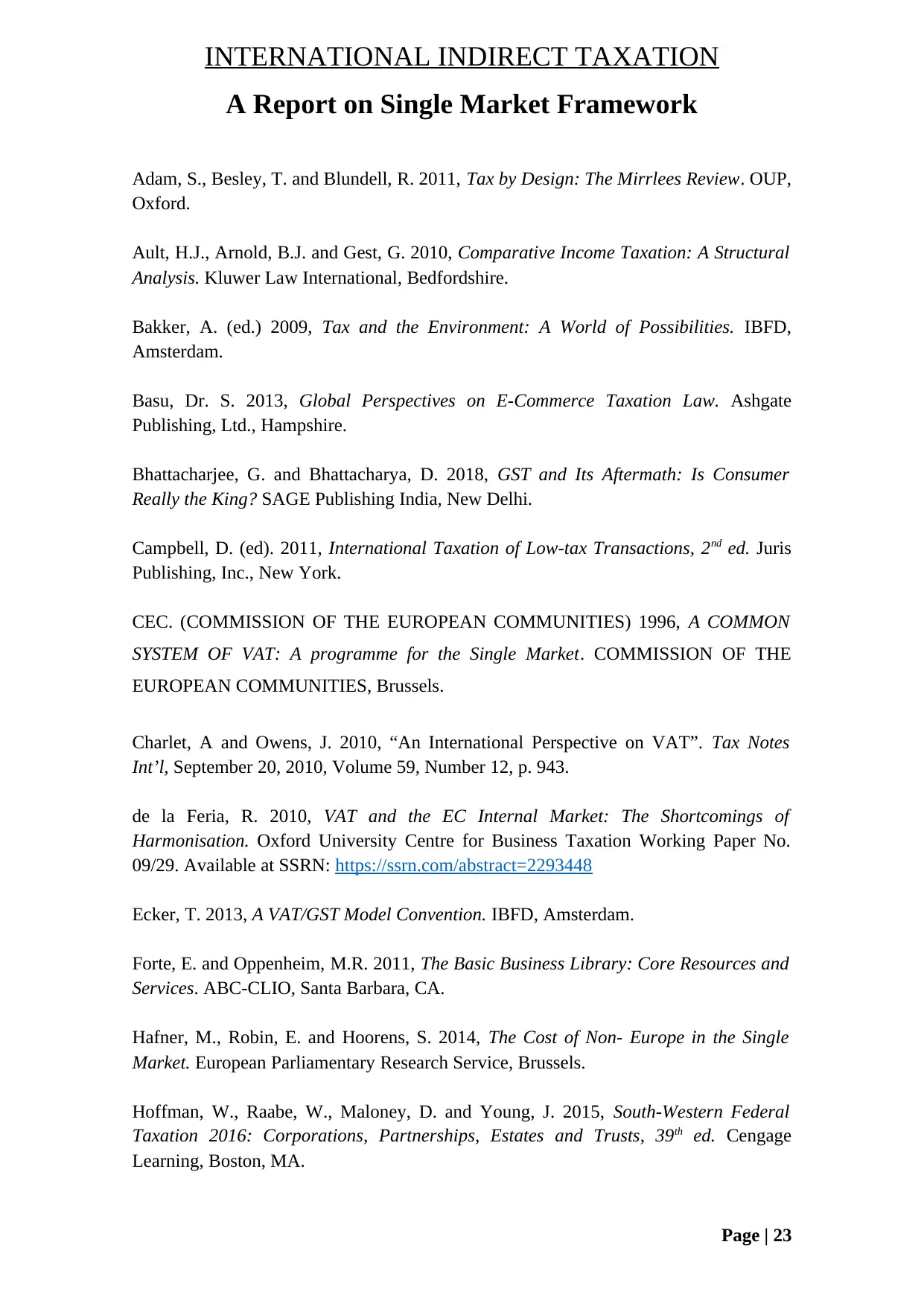
INTERNATIONAL INDIRECT TAXATION
A Report on Single Market Framework
Adam, S., Besley, T. and Blundell, R. 2011, Tax by Design: The Mirrlees Review. OUP,
Oxford.
Ault, H.J., Arnold, B.J. and Gest, G. 2010, Comparative Income Taxation: A Structural
Analysis. Kluwer Law International, Bedfordshire.
Bakker, A. (ed.) 2009, Tax and the Environment: A World of Possibilities. IBFD,
Amsterdam.
Basu, Dr. S. 2013, Global Perspectives on E-Commerce Taxation Law. Ashgate
Publishing, Ltd., Hampshire.
Bhattacharjee, G. and Bhattacharya, D. 2018, GST and Its Aftermath: Is Consumer
Really the King? SAGE Publishing India, New Delhi.
Campbell, D. (ed). 2011, International Taxation of Low-tax Transactions, 2nd ed. Juris
Publishing, Inc., New York.
CEC. (COMMISSION OF THE EUROPEAN COMMUNITIES) 1996, A COMMON
SYSTEM OF VAT: A programme for the Single Market. COMMISSION OF THE
EUROPEAN COMMUNITIES, Brussels.
Charlet, A and Owens, J. 2010, “An International Perspective on VAT”. Tax Notes
Int’l, September 20, 2010, Volume 59, Number 12, p. 943.
de la Feria, R. 2010, VAT and the EC Internal Market: The Shortcomings of
Harmonisation. Oxford University Centre for Business Taxation Working Paper No.
09/29. Available at SSRN: https://ssrn.com/abstract=2293448
Ecker, T. 2013, A VAT/GST Model Convention. IBFD, Amsterdam.
Forte, E. and Oppenheim, M.R. 2011, The Basic Business Library: Core Resources and
Services. ABC-CLIO, Santa Barbara, CA.
Hafner, M., Robin, E. and Hoorens, S. 2014, The Cost of Non- Europe in the Single
Market. European Parliamentary Research Service, Brussels.
Hoffman, W., Raabe, W., Maloney, D. and Young, J. 2015, South-Western Federal
Taxation 2016: Corporations, Partnerships, Estates and Trusts, 39th ed. Cengage
Learning, Boston, MA.
Page | 23
A Report on Single Market Framework
Adam, S., Besley, T. and Blundell, R. 2011, Tax by Design: The Mirrlees Review. OUP,
Oxford.
Ault, H.J., Arnold, B.J. and Gest, G. 2010, Comparative Income Taxation: A Structural
Analysis. Kluwer Law International, Bedfordshire.
Bakker, A. (ed.) 2009, Tax and the Environment: A World of Possibilities. IBFD,
Amsterdam.
Basu, Dr. S. 2013, Global Perspectives on E-Commerce Taxation Law. Ashgate
Publishing, Ltd., Hampshire.
Bhattacharjee, G. and Bhattacharya, D. 2018, GST and Its Aftermath: Is Consumer
Really the King? SAGE Publishing India, New Delhi.
Campbell, D. (ed). 2011, International Taxation of Low-tax Transactions, 2nd ed. Juris
Publishing, Inc., New York.
CEC. (COMMISSION OF THE EUROPEAN COMMUNITIES) 1996, A COMMON
SYSTEM OF VAT: A programme for the Single Market. COMMISSION OF THE
EUROPEAN COMMUNITIES, Brussels.
Charlet, A and Owens, J. 2010, “An International Perspective on VAT”. Tax Notes
Int’l, September 20, 2010, Volume 59, Number 12, p. 943.
de la Feria, R. 2010, VAT and the EC Internal Market: The Shortcomings of
Harmonisation. Oxford University Centre for Business Taxation Working Paper No.
09/29. Available at SSRN: https://ssrn.com/abstract=2293448
Ecker, T. 2013, A VAT/GST Model Convention. IBFD, Amsterdam.
Forte, E. and Oppenheim, M.R. 2011, The Basic Business Library: Core Resources and
Services. ABC-CLIO, Santa Barbara, CA.
Hafner, M., Robin, E. and Hoorens, S. 2014, The Cost of Non- Europe in the Single
Market. European Parliamentary Research Service, Brussels.
Hoffman, W., Raabe, W., Maloney, D. and Young, J. 2015, South-Western Federal
Taxation 2016: Corporations, Partnerships, Estates and Trusts, 39th ed. Cengage
Learning, Boston, MA.
Page | 23
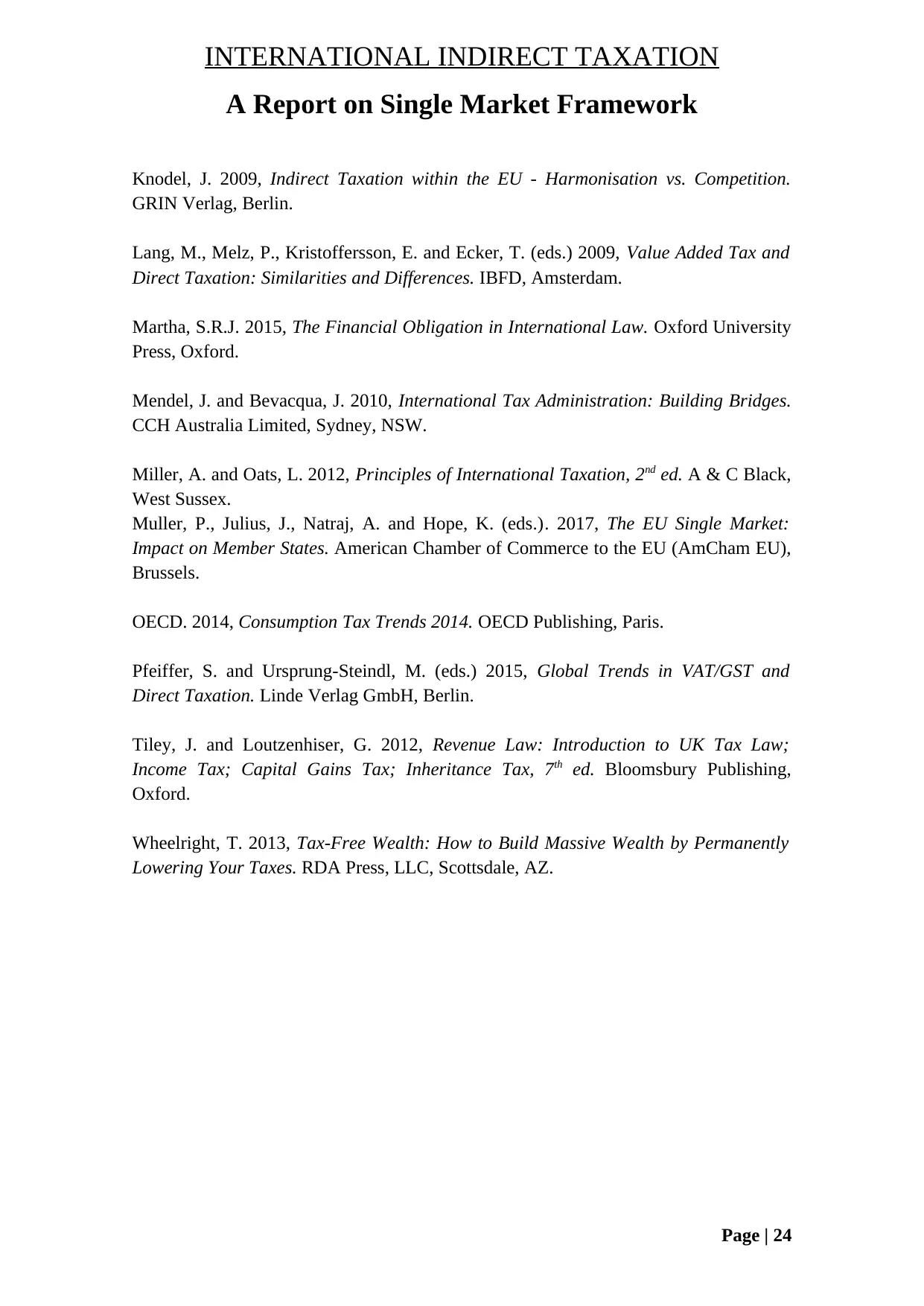
INTERNATIONAL INDIRECT TAXATION
A Report on Single Market Framework
Knodel, J. 2009, Indirect Taxation within the EU - Harmonisation vs. Competition.
GRIN Verlag, Berlin.
Lang, M., Melz, P., Kristoffersson, E. and Ecker, T. (eds.) 2009, Value Added Tax and
Direct Taxation: Similarities and Differences. IBFD, Amsterdam.
Martha, S.R.J. 2015, The Financial Obligation in International Law. Oxford University
Press, Oxford.
Mendel, J. and Bevacqua, J. 2010, International Tax Administration: Building Bridges.
CCH Australia Limited, Sydney, NSW.
Miller, A. and Oats, L. 2012, Principles of International Taxation, 2nd ed. A & C Black,
West Sussex.
Muller, P., Julius, J., Natraj, A. and Hope, K. (eds.). 2017, The EU Single Market:
Impact on Member States. American Chamber of Commerce to the EU (AmCham EU),
Brussels.
OECD. 2014, Consumption Tax Trends 2014. OECD Publishing, Paris.
Pfeiffer, S. and Ursprung-Steindl, M. (eds.) 2015, Global Trends in VAT/GST and
Direct Taxation. Linde Verlag GmbH, Berlin.
Tiley, J. and Loutzenhiser, G. 2012, Revenue Law: Introduction to UK Tax Law;
Income Tax; Capital Gains Tax; Inheritance Tax, 7th ed. Bloomsbury Publishing,
Oxford.
Wheelright, T. 2013, Tax-Free Wealth: How to Build Massive Wealth by Permanently
Lowering Your Taxes. RDA Press, LLC, Scottsdale, AZ.
Page | 24
A Report on Single Market Framework
Knodel, J. 2009, Indirect Taxation within the EU - Harmonisation vs. Competition.
GRIN Verlag, Berlin.
Lang, M., Melz, P., Kristoffersson, E. and Ecker, T. (eds.) 2009, Value Added Tax and
Direct Taxation: Similarities and Differences. IBFD, Amsterdam.
Martha, S.R.J. 2015, The Financial Obligation in International Law. Oxford University
Press, Oxford.
Mendel, J. and Bevacqua, J. 2010, International Tax Administration: Building Bridges.
CCH Australia Limited, Sydney, NSW.
Miller, A. and Oats, L. 2012, Principles of International Taxation, 2nd ed. A & C Black,
West Sussex.
Muller, P., Julius, J., Natraj, A. and Hope, K. (eds.). 2017, The EU Single Market:
Impact on Member States. American Chamber of Commerce to the EU (AmCham EU),
Brussels.
OECD. 2014, Consumption Tax Trends 2014. OECD Publishing, Paris.
Pfeiffer, S. and Ursprung-Steindl, M. (eds.) 2015, Global Trends in VAT/GST and
Direct Taxation. Linde Verlag GmbH, Berlin.
Tiley, J. and Loutzenhiser, G. 2012, Revenue Law: Introduction to UK Tax Law;
Income Tax; Capital Gains Tax; Inheritance Tax, 7th ed. Bloomsbury Publishing,
Oxford.
Wheelright, T. 2013, Tax-Free Wealth: How to Build Massive Wealth by Permanently
Lowering Your Taxes. RDA Press, LLC, Scottsdale, AZ.
Page | 24
Paraphrase This Document
Need a fresh take? Get an instant paraphrase of this document with our AI Paraphraser
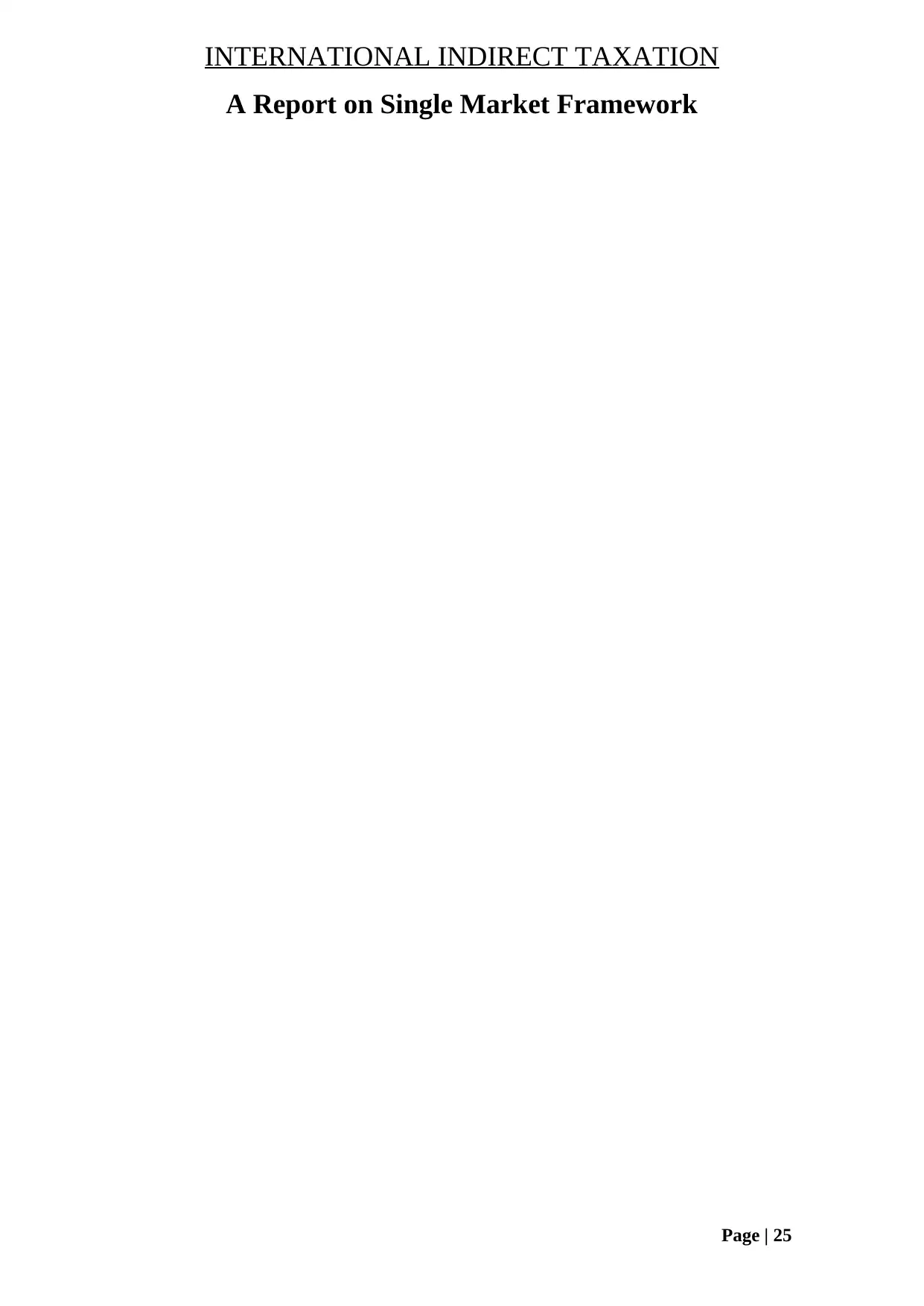
INTERNATIONAL INDIRECT TAXATION
A Report on Single Market Framework
Page | 25
A Report on Single Market Framework
Page | 25
1 out of 26
Your All-in-One AI-Powered Toolkit for Academic Success.
+13062052269
info@desklib.com
Available 24*7 on WhatsApp / Email
![[object Object]](/_next/static/media/star-bottom.7253800d.svg)
Unlock your academic potential
© 2024 | Zucol Services PVT LTD | All rights reserved.